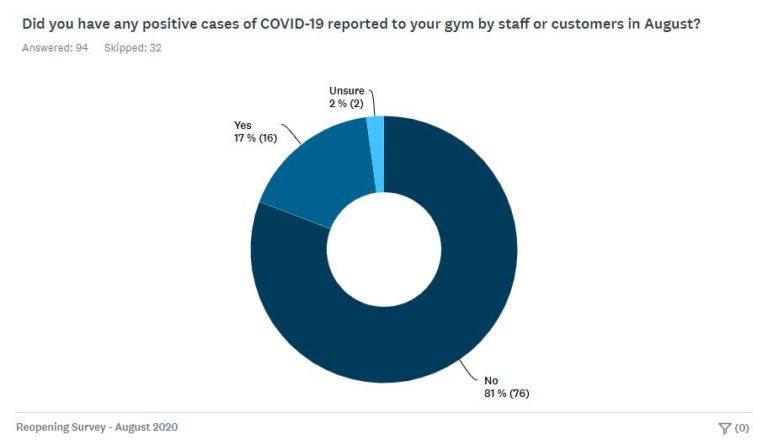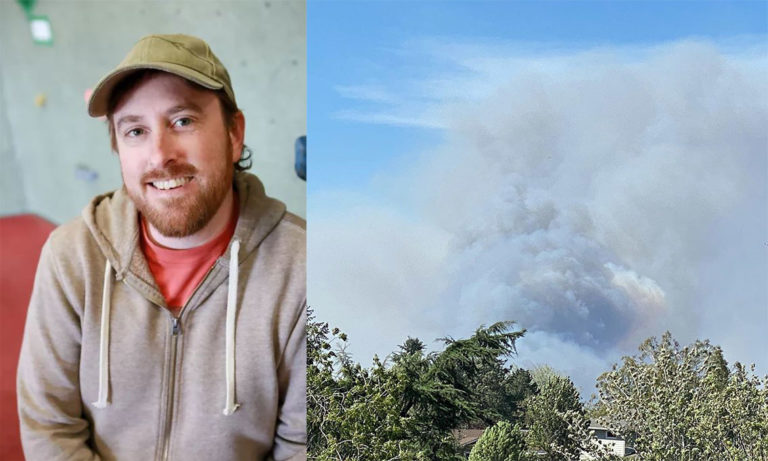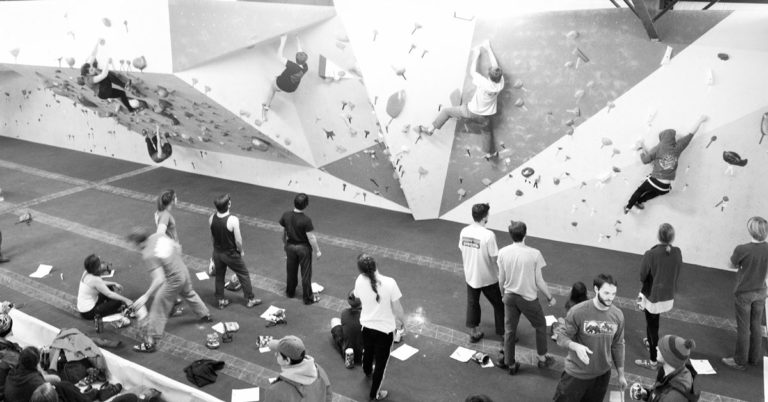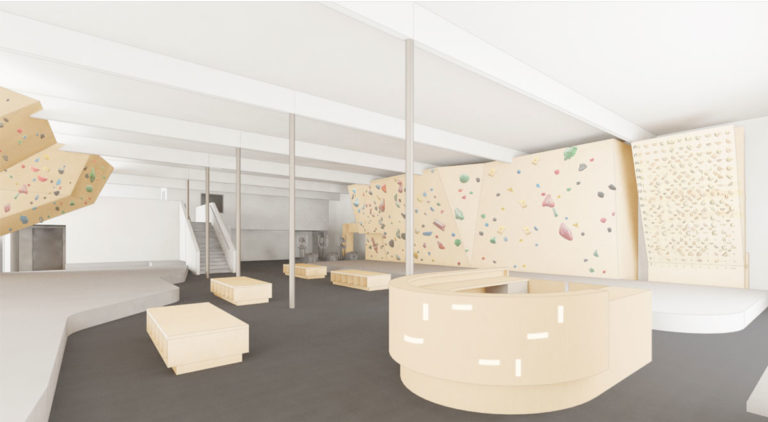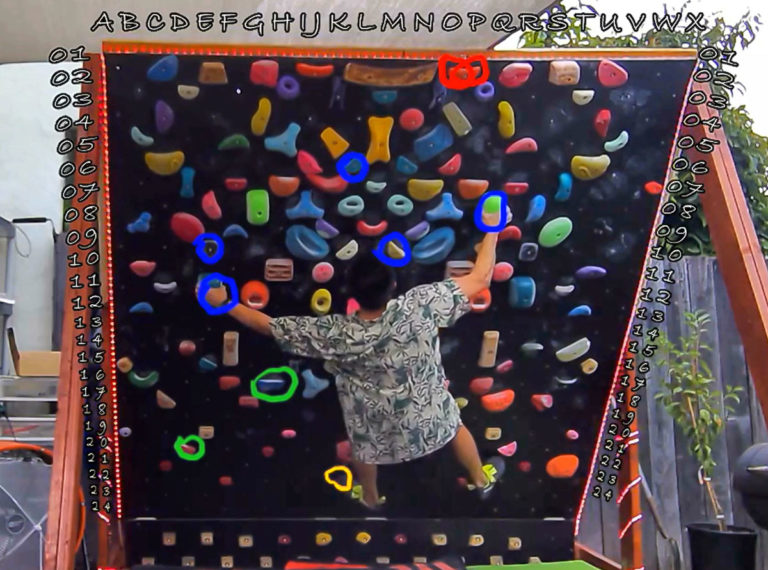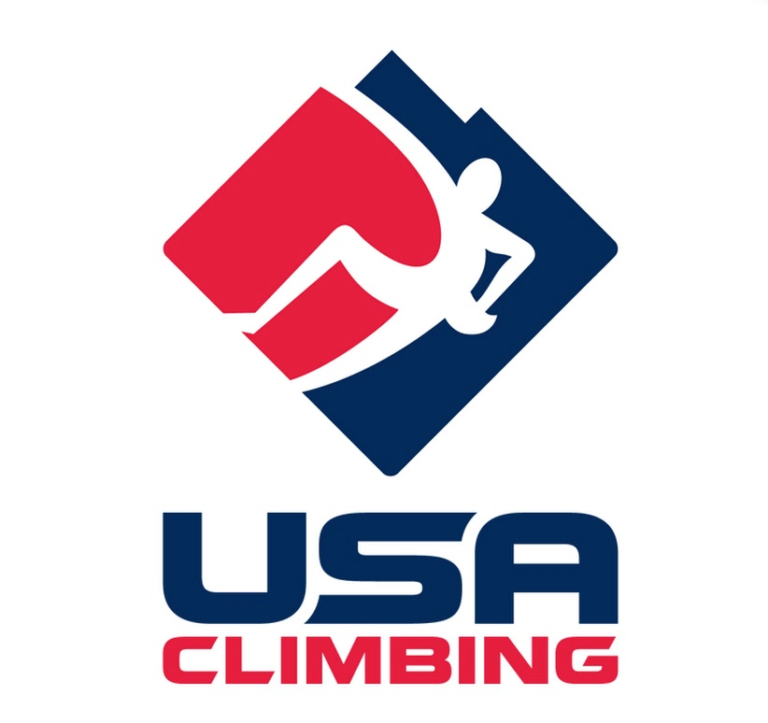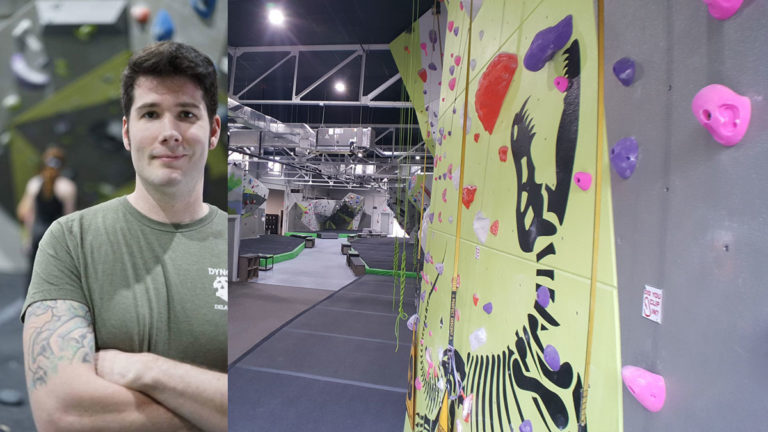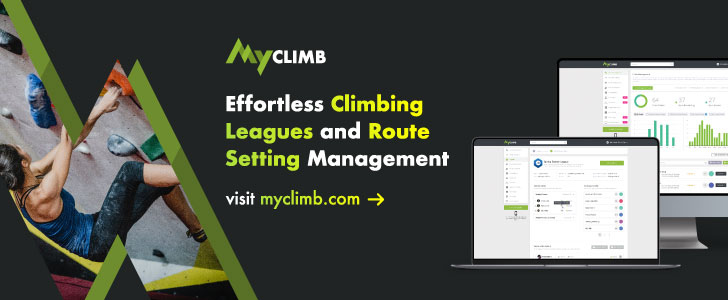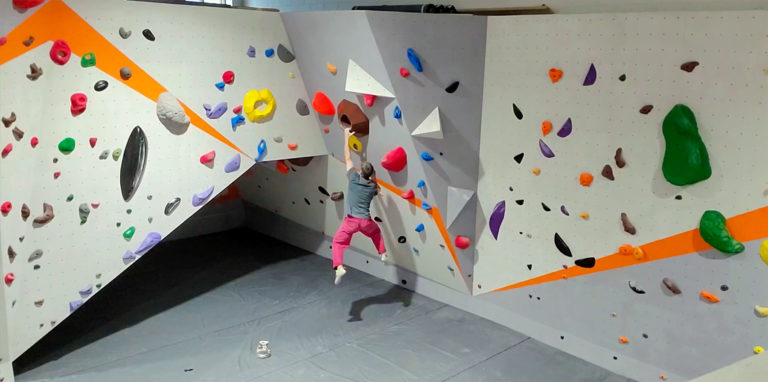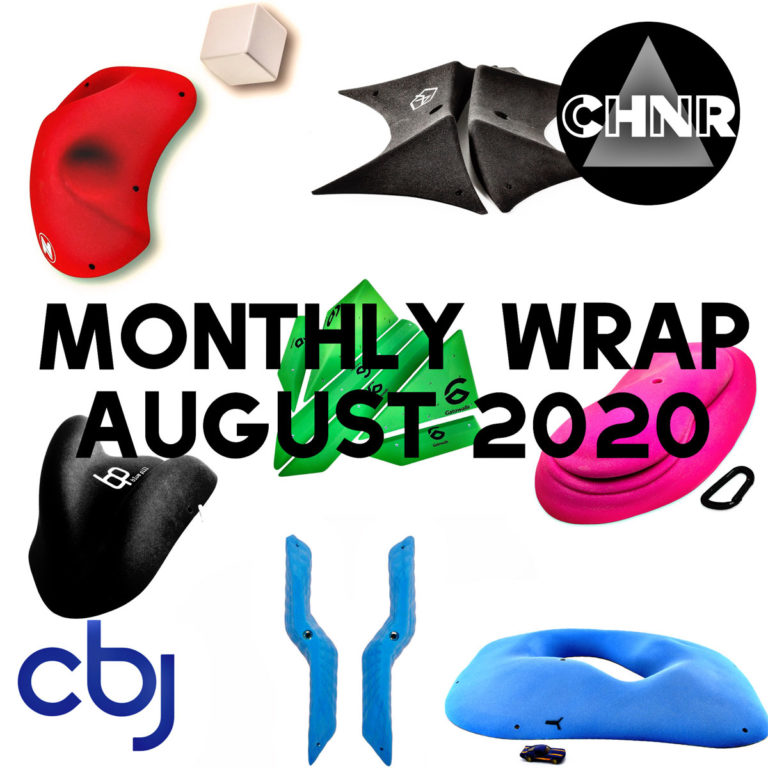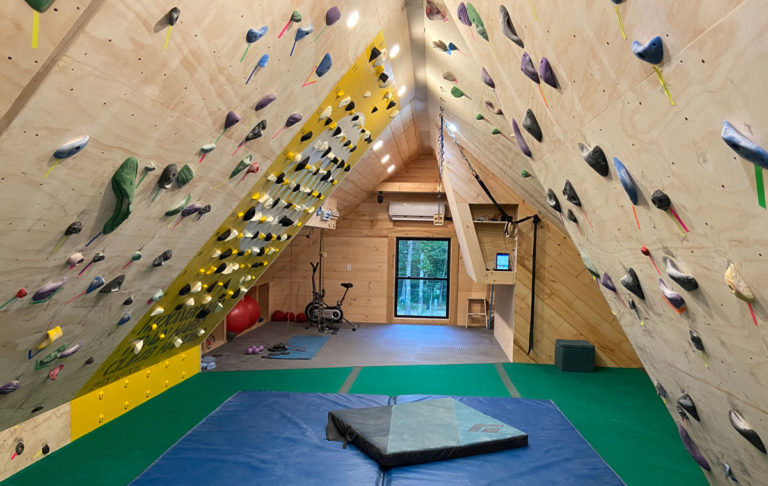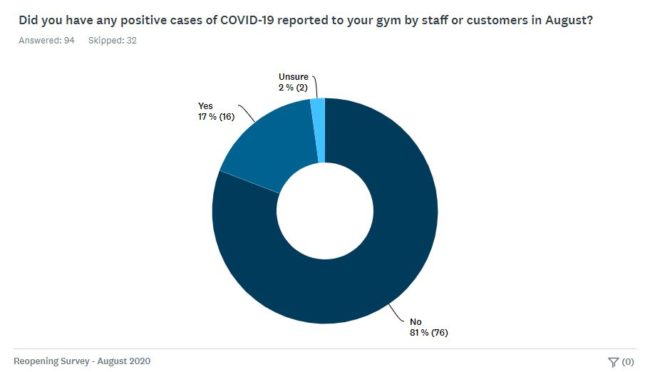
Encouraging Signs for Gyms in August CWA Reopening Survey Results

Our Gym Is Still Standing: Behind the Desk with Matt Lambert
Behind the Desk… is a series that interviews people who support and work in the climbing industry, and particularly those people who own and manage facilities. This week’s installment is a bit unique. Like others, we—at CBJ—have been following the news about the destructive fires out West. And we know that climbing communities in states like California, Oregon and elsewhere are just some of the many communities that are being displaced, discouraged or otherwise harmed by the resulting fire destruction. So, we wanted to reach out to an owner of a climbing gym that is being impacted by a fire to learn more details, gain a first-hand account, and hear how those in a given climbing community are doing. Matt Lambert, owner of Rogue Rock Gym, was kind enough to chat with us about all that in this edition of Behind the Desk while the fire damage and devastation sadly continues.
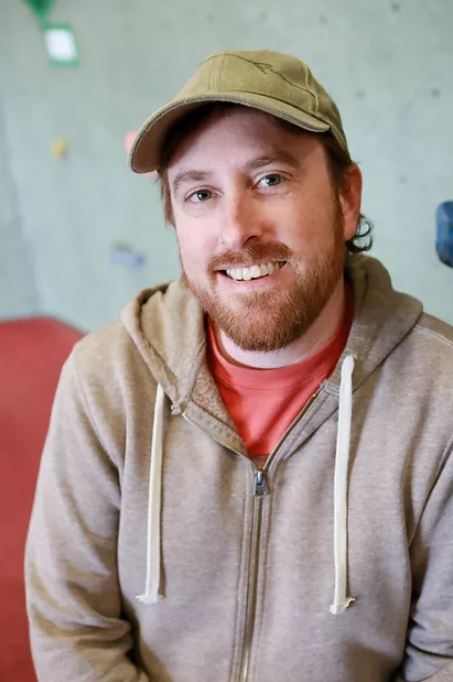 Name: Matt Lambert
Title: Owner, Rogue Rock Gym
Location: Medford, OR
Name: Matt Lambert
Title: Owner, Rogue Rock Gym
Location: Medford, OR
 Name: Matt Lambert
Title: Owner, Rogue Rock Gym
Location: Medford, OR
Name: Matt Lambert
Title: Owner, Rogue Rock Gym
Location: Medford, OR
CBJ: Can you tell me specifically about the fire in your area?
LAMBERT: I actually live right near where a fire started on Almeda Street. Ironically, Almeda is fine, as the fierce winds blew the fire in the opposite direction. It was a 100-year-wind event with 40-mile-per-hour winds. The fire ran 10 miles northwest and ran within a few blocks from Rogue Rock Gym, destroying two towns, thousands of homes, and over 100 businesses along the way. It was unstoppable, and a devastating tragedy. It was a long sleepless night listening to the police and fire department scanners, wondering if my rock gym would burn or be spared. Fortunately, the fire department established a hard line one block from our gym in order to prevent the fire from advancing into the city of Medford. At about 3:00 am, power at the gym came on and I could see our security cameras that she was still standing. It was a Hallelujah moment! We had to remain closed for a full week because the police had shut down access to the entire area surrounding the gym. There were active fires spotting up, downed power lines, and they were trying to prevent looters from going into the abandoned homes and businesses. We were just able to open yesterday, and they are just starting to let residents back into the area; sadly many of them are returning to piles of ashes and rubble.CBJ: I saw on Instagram Rogue Rock Gym stated, “Anyone who was displaced by the Almeda Fire is welcome to use our showers and WiFi and get out of the smoke.” That is a wonderful gesture. Where did that idea come from?
LAMBERT: There has been a huge outpouring of support from the community to help those families displaced by the fires. Donation centers have been established all over town. Many local businesses are opening their doors to displaced fire victims, as many people have nowhere to go, and the outdoor air quality is extremely hazardous. We made the offer on our social media to participate in the community relief effort. We are planning a fundraising event at the gym in the near future. Of course, with Covid-19 restrictions, hosting “events” is a bit tricky, so we are needing to get creative. We have several gym members who lost everything in the fires. Other members have already stepped up to offer them replacement climbing gear. Another thing we are going to do to support the relief effort is donate all new member initiation fees to a fund set up through our local credit union—who is matching all donations.CBJ: The fires have been physically destructive—horrifically and tragically so. What has it been like mentally amid all this?
LAMBERT: Everyone in the Rogue Valley area has been on high alert for a week now, ready to evacuate at a moment’s notice. People’s stress levels are extremely high. Everyone knows someone who has lost everything. It is mentally and emotionally draining for the entire community. We were eager to get the gym back open as soon as possible because so many people use the gym not only for physical fitness, but for their own mental health. Climbing is an amazing stress-reliever that can help everyone get through hard times. We are happy to still be able to provide that space for people to relieve stress when the options for exercising outdoors are extremely limited due to the poor air quality.CBJ: And specifically about the air quality: How is Rogue Rock Gym dealing with the issue of hazardous air as a result of the fire?
LAMBERT: Hazardous air quality is something we regularly deal with in Southern Oregon this time of year during the wildfire season, more so in the last few years. Our gym is at a disadvantage because our HVAC system is made up of Swamp Coolers which pump air from outside into the gym. Right now we can’t use them, or the entire gym becomes filled with smoke, but luckily the temperatures have dropped down to the low 80s making climbing with no AC bearable. We have also built our own version of “chalk eaters” for the gym and put filters in them rated for smoke particulates. Running three of these units in the gym helps improve the air quality considerably. Yesterday at our re-opening we had 70 climbers in the gym throughout the day. It feels great to welcome the community back. For many of our members Rogue Rock Gym is like a second home, a sanctuary, a playground, a club house of sorts where they connect with their friends and neighbors. We are eternally grateful to our local first responders, police and fire who have worked tirelessly to protect our town. It is through their hard work that our gym is still standing. Our deepest condolences go out to everyone affected by the Almeda Fire in Ashland, Talent, and Phoenix.Share your story
Are you leading a climbing gym or brand through this unprecedented period? Or, do you work in the industry and have a story that others could benefit from hearing? If so, please contact us and tell us about it.Healthy Client/Advisor Relationships for Gyms: Granite Insurance Shares
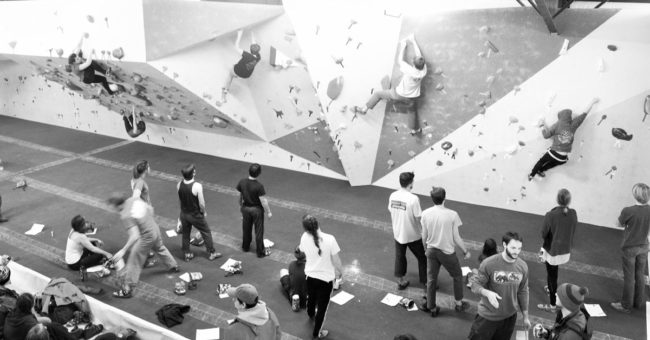
Building A Relationship for the Long Haul
Ruthie Lile, who leads Granite Insurance’s climbing gym vertical, says “The role of an insurance agent and risk advisor has changed significantly over time. It can’t just be a once a year insurance transaction but needs to be an ongoing conversation through the year where a much more comprehensive risk mitigation strategy is discussed.” Especially in industries like ours, that kind of guidance is key. Risk mitigation strategies (and therefore insurance implications) are present in just about everything gyms do―the creation of employee handbooks, formulation and implementation of operational procedures, determination of waiver content, brainstorming of emergency protocols and response plans, training of staff, interacting with participants―the list can keep on going. Your advisor should be present in all of these strategy conversations. After a gym is open and operating, these needs grow and morph, and new challenges and ideas constantly enter the mixing bowl that need to be addressed. Your agent and advisor should be on speed dial in your phone, someone you can lean on consistently to address these questions. Your advisor can even offer management training sessions on subjects like how to deal with a participant or an employee injury. While your agent/advisor does get paid via commission from your insurance policies, it’s in everyone’s best interest to keep your insurance costs down because that will result in a longer-standing and more quality relationship overall. Being a key part of these non-insurance risk mitigation strategies not only helps further the quality of that relationship, but also reduces the likelihood of insurance needing to respond to a claim in the future―therefore, keeping premium costs down for you.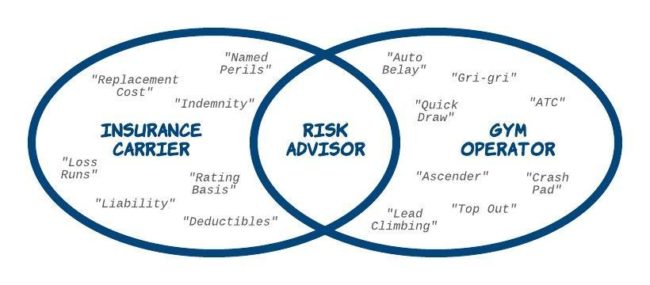
Asking the Right Questions (Sooner and More of Them)
A lot of your agent’s job also revolves around education. They are either educating the insurance carrier about the climbing industry, educating gym owners and managers on how the insurance world works, or furthering their own education in both. It pays to have a curious advisor who asks questions and who asks them early on in the process. How many of you readers have had an insurance proposal provided to you just a week or two before the policies bind, leaving your hands tied without the runway needed to explore other program options? The conversation around your insurance program should ideally begin at least 4 months prior to your current policy’s expiration date, giving you plenty of time to discuss options with your advisor and make the best decisions for your business. The more questions your advisor asks you, the more they can tailor your program to your unique operation, and the less likely they are to leave you with unintentional liability exposures. And on the other side of education needs, the more your advisor can educate the carriers they work with in the climbing industry, the more it can positively affect your insurance premium. Carriers price for the unknown―if a risk scares them, they’ll either turn the opportunity down or they’ll accept it but charge more premium for it. With education comes understanding, and with understanding comes opportunity for premium management. Insurance premium determination is a complex calculator with many different factors taken into consideration, but carrier education is one of those factors that should be paid close attention to.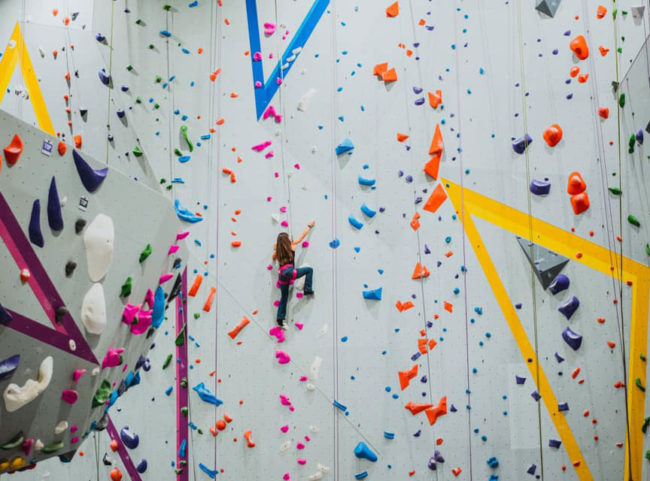
Supporting Gym Development
The Riveter is one of the climbing gyms making use of this trusted approach to client/advisor relationships. First opened in February, The Riveter is a premier indoor climbing gym and unique outdoor bike park combo located in Mills River, North Carolina. The gym boasts over 16,000 square feet of climbing terrain, plus a dedicated training area―with a Kilter board and Tension rungs―and kids climbing cove. There was a long runway to launching such an involved project, a process that lasted over two years as the gym was under construction and planned out the details of its operations. From conception, Granite was instrumental in the development of The Riveter’s risk management program and secured themselves as a true part of the team rather than just a vendor to the gym. They talked through the evolution of an insurance program―what policies should be in place pre-construction, during construction, and then finally during operations. Granite also provided guidance on how to budget for insurance and on the creation of policies and procedures, including manuals and emergency action plans. They facilitated an in-person loss control visit with an insurance carrier, and once The Riveter was open they offered management training on how to deal with a participant or a staff injury. “Working with Granite Insurance has far exceeded my expectations of what my relationship with my insurance agent and risk advisor should look like,” says Elizabeth Jackson, owner of The Riveter. When Covid-19 hit the world, Granite’s team reached out to Jackson pro-actively to discuss reducing her revenue & payroll projections, aiming to assist with any possible cash flow hurdles that might arise. These are the types of actions you should expect and the type of support you should be receiving from your advisor.Starting the Conversation
Granite Insurance works in all insurance coverages applicable to the climbing gym industry and offers a premier program to those gyms who want a true risk management partner. They believe in quality, and they seek out gyms who share that sentiment and who want to excel in their risk management plan and lead the industry. To begin a conversation with Granite Insurance about your own risk management program, Ruthie Lile can be reached at rlile@graniteinsurance.com.This story was paid for and produced by the sponsor and does not necessarily represent the views of the Climbing Business Journal editorial team.
New Seattle-Area Bouldering Gym will be “Purpose-Built” for Climbers
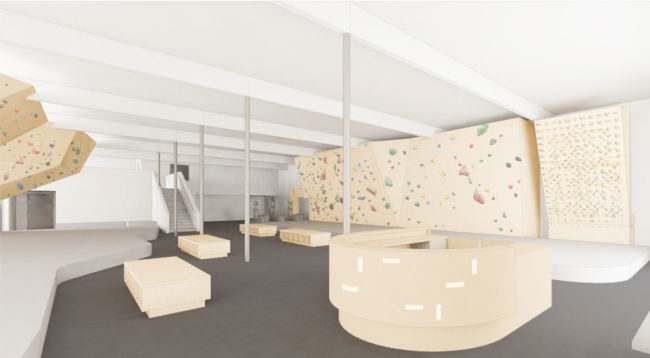
Uplift Climbing Shoreline, Washington
Specs: 7,300-square-foot facility will be bouldering-only, featuring 14-foot-tall walls that will vary in overhanging angles from 5-degrees to as much as 60-degrees. Additional amenities will include hangboards, campus board, a MoonBoard and a Tension Board. Cardio and weightlifting equipment will also be offered. Gym programming will range from community events to classes and outdoor stewardship, according to a press release. The gym will reside in a longstanding building that served as a library in the 1990s—and a disco club in decades prior to that. The press release also noted that a “family-friendly” brewery—Monka Brewing Company—will be adjacent to the gym.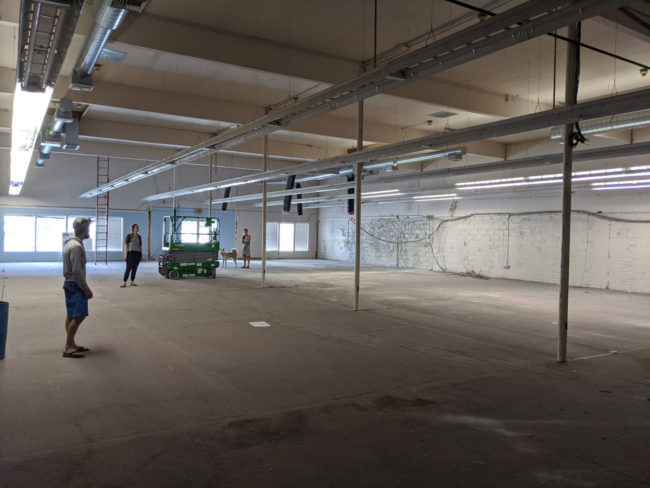

HWOW 22 – A West Coast Adjustable System Board
This week’s homewall lives in Santa Ana, CA and uses music-reactive LED light strips to spice up backyard training sessions. Owner My V. replaced the upright supports with ratchets to turn his second-hand board into an adjustable and symmetrical masterpiece. Check out past HWOW here.
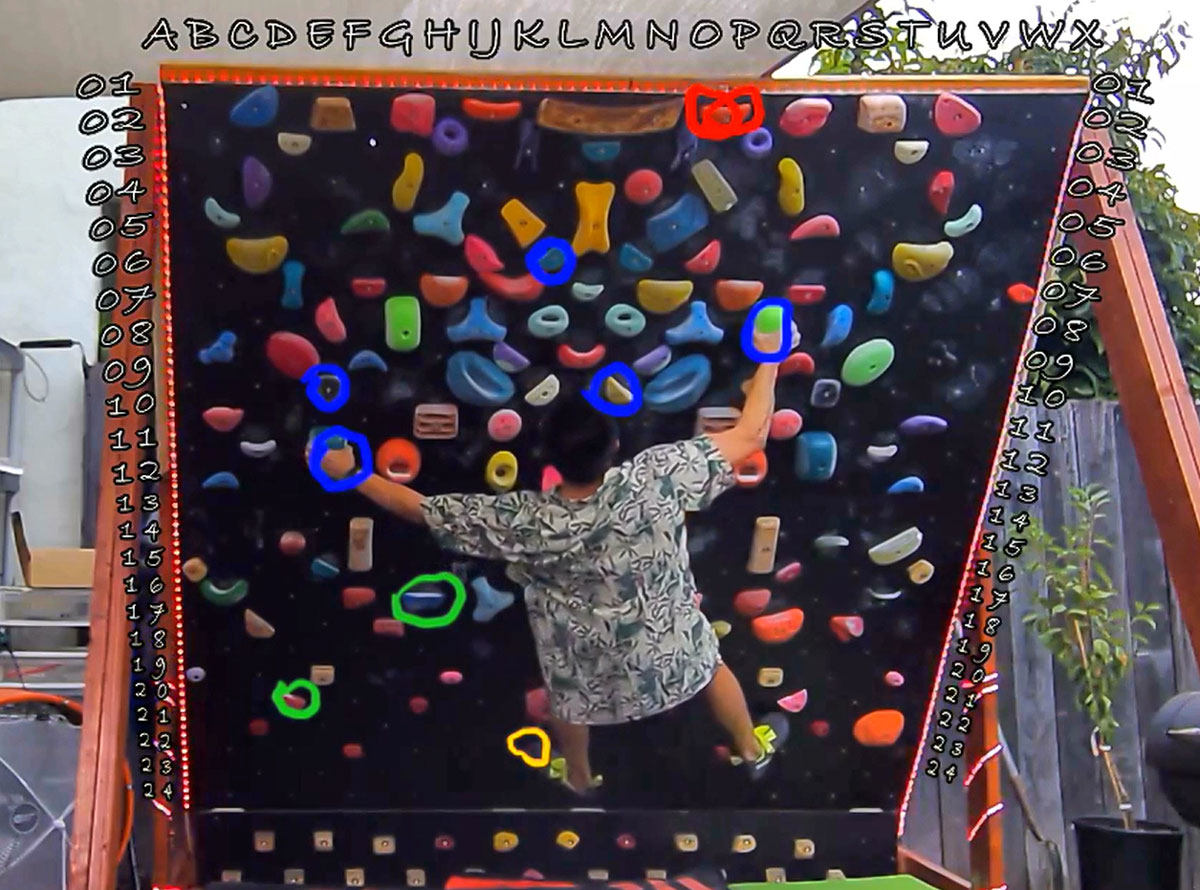
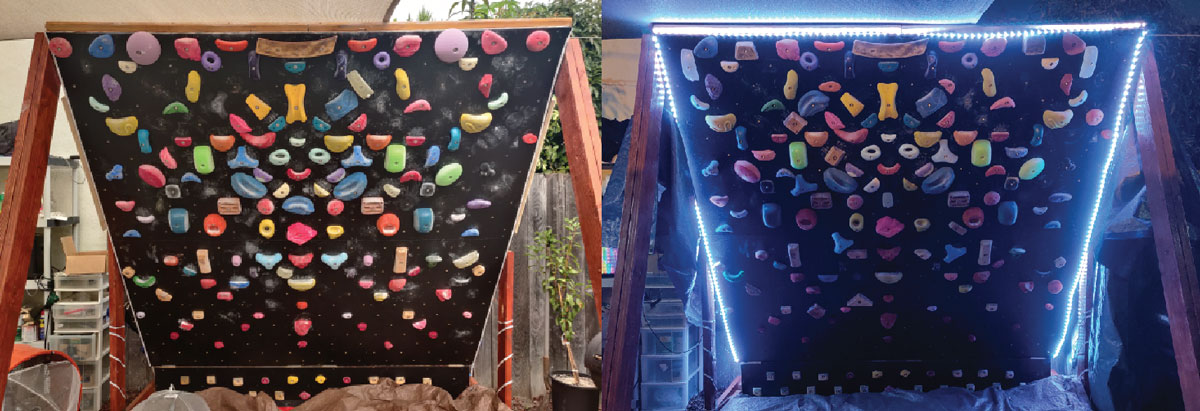
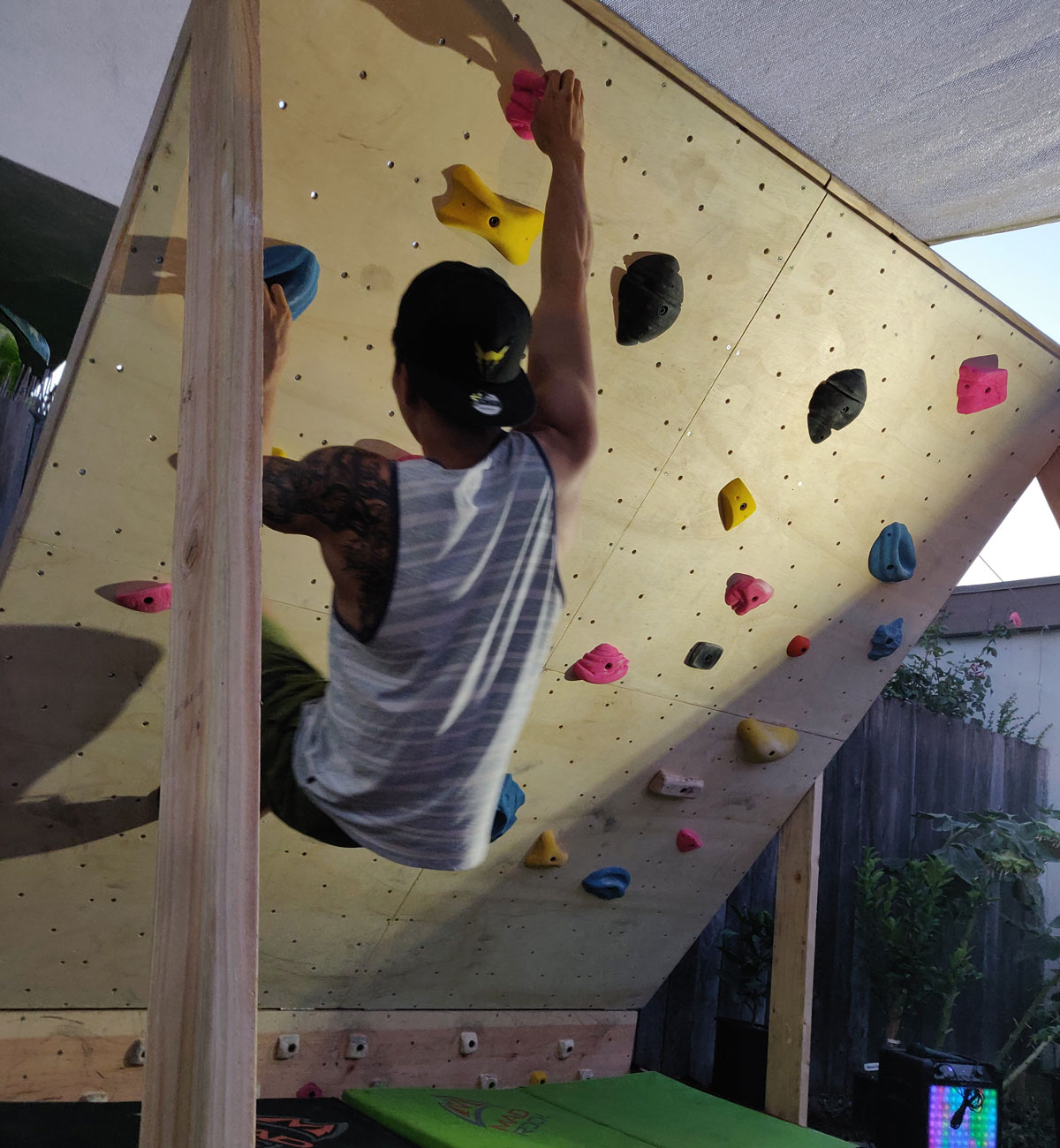
Want us to consider your woodie for a future Homewall of the Week? Submit your homewall here to be considered. If yours is chosen you’ll win a prize like this (prizes vary each week):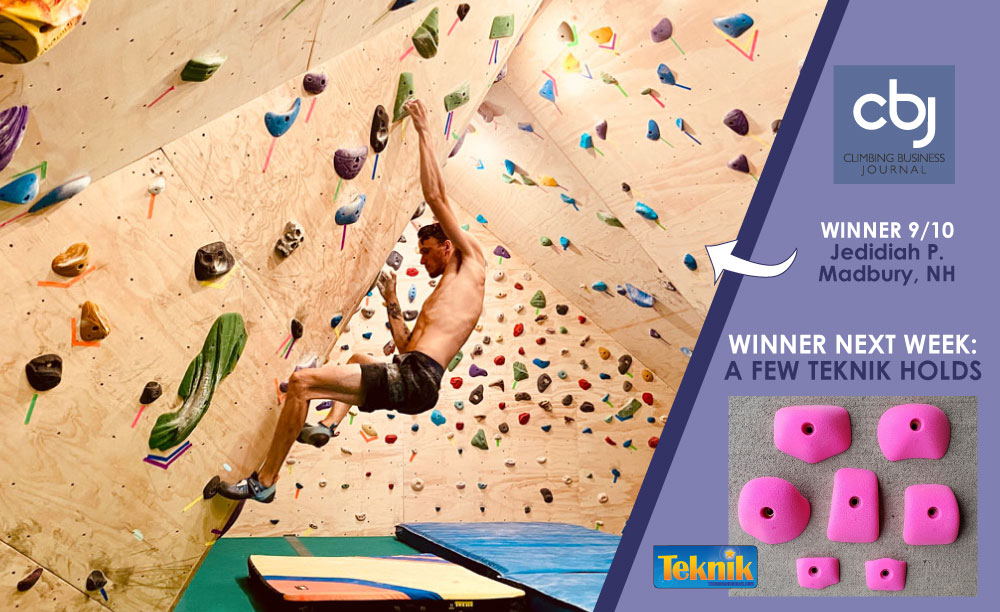

When did you build your wall? Was it a COVID baby?
End of June, so yes to Covid baby. I bought it second hand! Then I completely revamped the design, which was my plan from the start.How long did it take you to build and what did that time look like?
It’s an on-going process of revisions, but I got it up and running the day I brought it home and was climbing on it that night.What did the revamping look like? What was already built and what specifically did you have to re-do?
The revamp was extensive and at the same time not. The wall itself is unrecognizable now, but it took much less effort/time than building one from scratch (Image 1 and 2). It was kept indoors and had a fixed angle design. Here’s what was changed: 1. Replaced horizontal supports with a ratchet to vary the angle, as well as changing the vertical support design. 2. Doubled up the main vertical support legs. 3. Stained the support legs, primed and painted the climbing surface. 4. Tap covered the back since it’s now outdoors. The design itself was very good, but I knew I wanted an adjustable wall, and I made that happen day 1 of owning it.Not including holds and padding, how much did it cost you to build? Any surprises there?
$400 including holds. I used about 30 plastic holds and about 30 homemade wooden holds! It was a steal! The surprise came in the amount of money I spent on holds.What made you decide to go with a symmetrical, system-wall layout? Did you always have that format in mind?
I didn’t plan on having a symmetrical system-wall layout. My first lay out was a spray wall, but as I kept acquiring more and more holds, I realized I could give the symmetrical lay out a shot and I LOVE IT. It’s not perfect due to slight variance in holds, and a layout that’s not meant to be symmetrical, but I make it work. It has made setting and training twice as efficient. I only have to set half the climbs since if I set a climb that is symmetrical, I can then try it immediately on the other side. It also helped me identify some glaring weaknesses I have, such as pinch strength and lock off strength.What are you doing for padding?
Crashpads from myself and friends. At the moment I have 7 crashpads. A tri-fold, three bi-folds, and an R3 that I borrowed from friends. And two R3 pads of my own. One of the pads is used simply as a bench to relax and watch though.
What was your primary incentive for the wall? Did anything in particular inspire your wall design?
Covid closed down the gyms and I don’t like the time investment required to go outdoors. I needed to climb, and hangboarding wasn’t enough. So, the wall was born. @sendstory has a great design that I heavily based my design off of.What was the most difficult aspect of the design and build?
My backyard had an atrocious layout and I’m a renter. The base of the wall sits on dirt, while the rest sits on cement that isn’t even leveled! Navigating around all of that took some effort since I can’t do much as a renter.How did you end up leveling the ground for your wall? Did you run into any issues with your landlord?
The base sits on dirt that was originally 2-3 inches lower than the concrete, I fixed that by buying dirt and eventually mulch which was cheaper to level it out. I then threw on a wood board on top to create a flat stable surface for the base to sit on. For the uneven concrete it wasn’t a perfect solution, but I kind of just drilled holes slightly offset. Didn’t really measure anything, I could have made it more precise and accurate I’m sure, but it’s stable and feels sturdy.What would you do differently?
Let the paint cure longer, but aside from that, it’s perfect. The only other issue was the varying price of holds.Did you make any mistakes along the way or choose to re-do any aspects?
Definitely, but none of them are permanent so it’s okay. When I own my own place, I plan to build a much better wall, so it’s been good practice.
What mistakes did you make and what aspects did you choose to re-do?
No major mistakes come to mind as everything was salvageable. I’d add onto the paint or not to paint debate. I think painting would’ve worked wonderfully if I let it cure twice as long as I did. I used truck bed liner paint on my wall since it’s durable and has slight texture. After letting the paint cure for the advertised time, I put some holds on, which stuck to the wall, damaging the plywood and forcing me to remove them. However, I had no issues with holds sticking or paint coming off of areas that had more time to cure. I’ve also started chalking the back of my holds prior to placing them on, which may have also helped mitigate the hold sticking issue.What is your favorite aspect?
The LED light strips around the perimeter that react to music input. It works great for illuminating holds during night climbs. It also gets me hyped before a send.How often do you use the wall? Do you think you’ll still use it as much when all of the gyms open back up?
3-4 times a week. I plan to freeze my membership for about a year to recuperate costs that went into my woody, even when gyms open up.Any words of wisdom to aspiring homewallers?
The wood isn’t the expensive part, it’s the holds that will drain your wallet.Want us to consider your woodie for a future Homewall of the Week? Submit your homewall here to be considered. If yours is chosen you’ll win a prize like this (prizes vary each week):

USA Climbing Partners with KAYA for Upcoming Virtual Comps
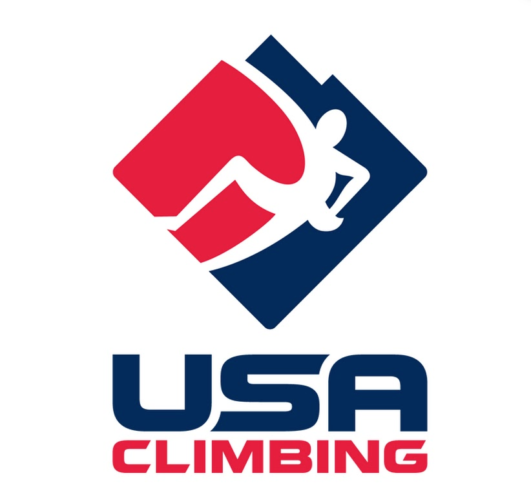
Community as a Long-Term Investment: Behind the Desk with Britton Frankel
Behind the Desk… is a series of interviews with people who support and work in the climbing industry, and particularly those people who own and manage facilities. For this week’s installment, CBJ heads to Central Florida to talk to Britton Frankel, co-owner behind the desk at DynoClimb. The family-owned and family-operated gym’s stated mission is: “to make a lasting impact on the community through climbing.” We wanted to unpack that a bit—and explore aspects of that stated mission that might be applicable to other gyms.
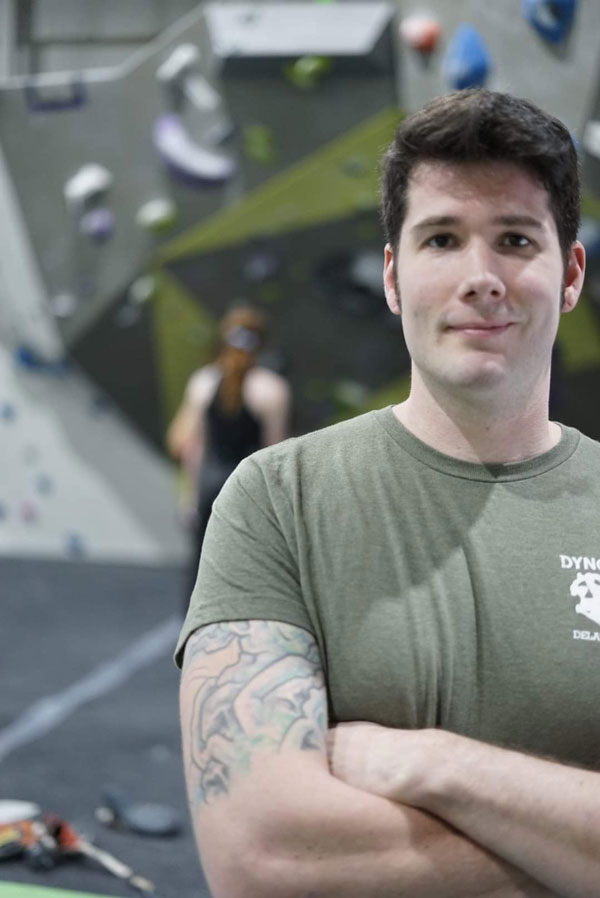 Name: Britton Frankel
Title: Community Leader, DynoClimb
Location: DeLand, Florida
Name: Britton Frankel
Title: Community Leader, DynoClimb
Location: DeLand, Florida
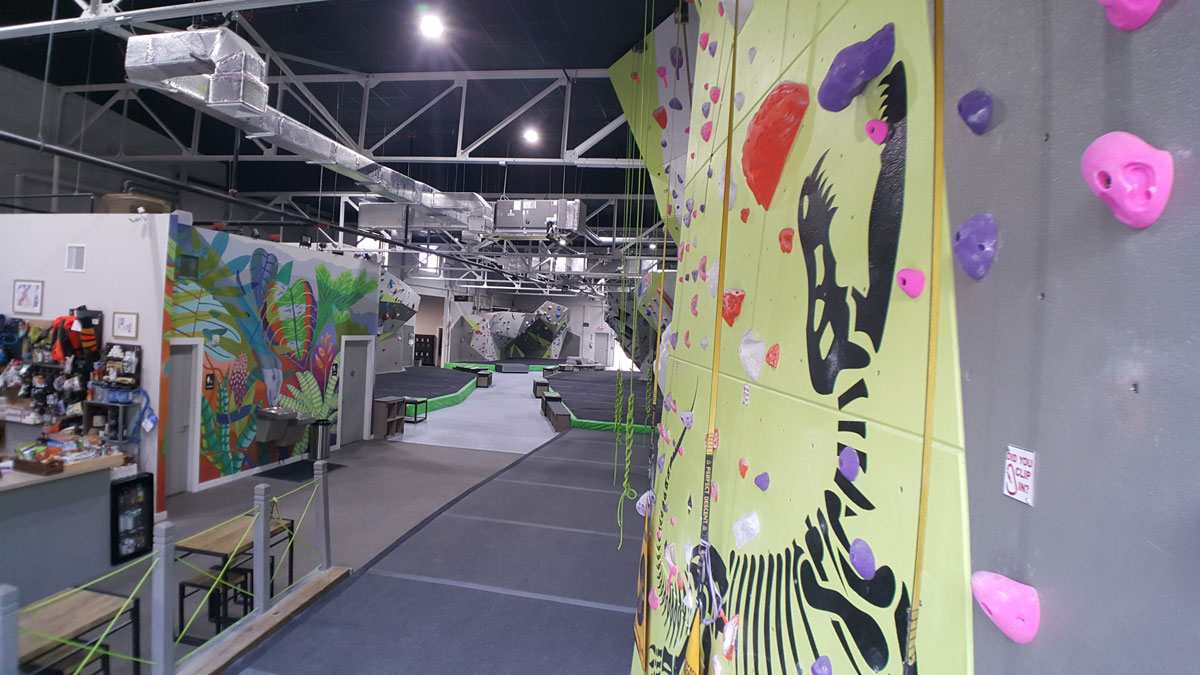
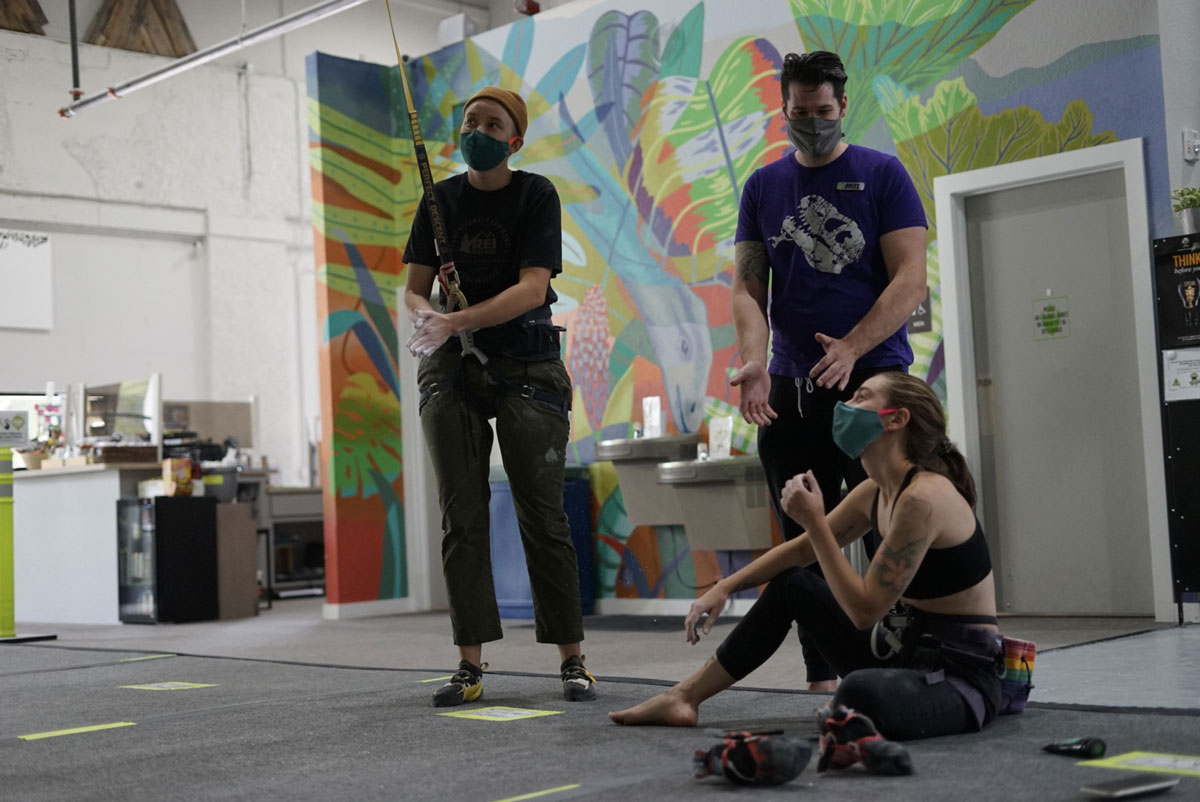
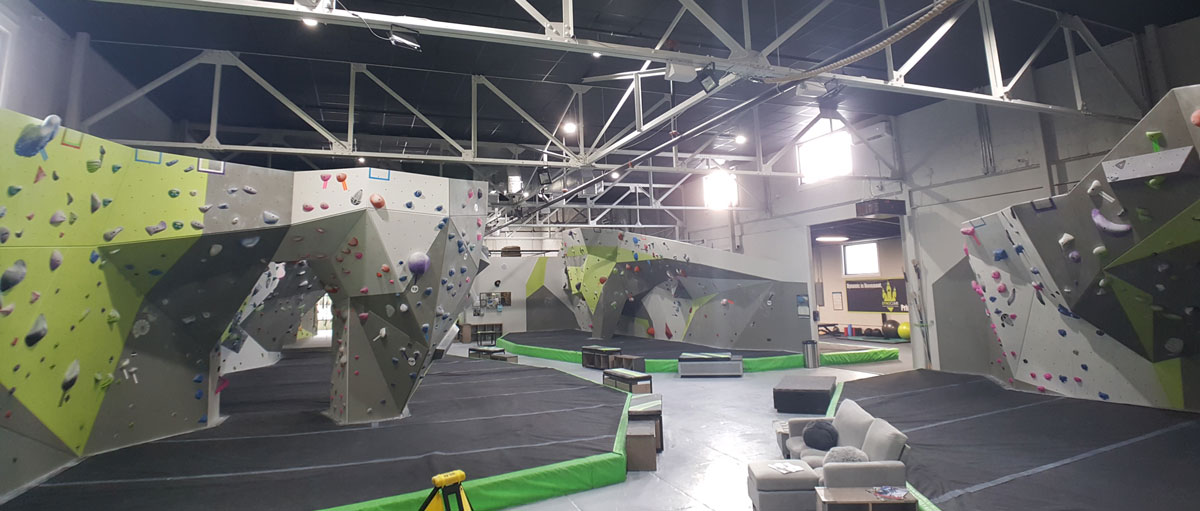
 Name: Britton Frankel
Title: Community Leader, DynoClimb
Location: DeLand, Florida
Name: Britton Frankel
Title: Community Leader, DynoClimb
Location: DeLand, Florida
CBJ: First off, I’d love to know about the gym scene in Florida, and specifically how you Dyno came to be.
FRANKEL: The Florida rock climbing scene is definitely a unique one. Being that there is no outdoor climbing—except Blowing Rocks down south—Florida climbers have developed a very tight-knit and booming indoor rock climbing community. In the last couple of years, the growth of climbing in Florida has truly started to fully develop. Pockets of climbing communities had been established with a handful of tenured climbing facilities that lead the groundwork for the expansion of the Florida climbing scene we now see today. Even as I write this I know of two other climbing gyms breaking ground—and others on the horizon. This is now set to be the Golden Era of Florida climbing and the climbing community that Florida so deserves. I started my journey in climbing on the walls of Devil’s Lake and Governor Dodge, Wisconsin, at the age of twelve. I was hooked; climbing became my Zen space, my way to challenge what I saw possible in myself, and my full mental and physical workout. Fast-forward many a year, to the moment that changed it all. I had hidden a note on the top of a blind ledge on what was the original Warrenville [Illinois] location of Vertical Ventures. Little did I know that note would bring me to where I am today. On belay, belay on, climbing, climb on—she was up and away, climbing ever closer to that hidden note. “Hey, there is something up here,” she said. On her descent down from the route I was ready for her to read the note—a note asking her to marry me. Fast-forward a couple more years and she and I find ourselves living in her hometown of DeLand, Florida. Now all we needed was to open a rock gym.
CBJ: Your title at Dyno is listed as “Community Leader. What does that mean—and what does the job specifically entail?
FRANKEL: So, my official title is CEO, but honestly that isn’t what I would like to be known as. For me, the climbing community and the beautiful sport of rock climbing has impacted and shaped me as a person. Ultimately this is how I see DynoClimb, as a dynamic community of climbers and fitness enthusiasts. My day-to-day responsibilities are to ensure that we deliver on our company mission statement and ultimately create an environment where everyone can all rise together. And ultimately this filters down to driving a consistent approach to day-to-day operations, organic growth within operations and policies, business operations, brand presence, and consistency, athlete—our members and climbers—interactions, and extended community engagement through events and social media.CBJ: I think a lot of gyms really strive to focus on community engagement in some form or another. Can you give any examples of things that have worked for you—and offer advice for other gyms that want to connect with their given communities?
FRANKEL: The biggest thing I have found is consistency in engagement. A community is a long-term investment of time, energy, growth, and relations. To truly foster community engagement, it has to be natural. For us this starts within our four walls. Our team is passionate about climbing and from the first moment you walk into our doors. We want to ensure you an experience that is memorable, positive, and uplifting. For our DynoFam (Members), we try to offer unique experiences, events, and offerings that truly show that we are much more than a fitness facility. More so than ever, people long to feel close again—but we all must distance for obvious reasons. The balance in that for us has been to offer alternatives through social media for comps and contests. Events that we have done within this past month include two separate night-climb events—blacklights/lights out with a limited capacity of 30 participants, a Dyno Comp, Speed Climb Comp, and Kilter Board competition.
CBJ: Something fairly unique about your gym is that you’ve had to close a few times due to severe weather—obviously Florida has the issue of hurricanes from time to time. What is it like operating a gym in a region where weather can be so infamously temperamental and force abrupt gym closures?
FRANKEL: Weather is definitely something that one can never truly prepare for, and being in Florida we see our fair share of hurricanes and tornadoes. We actually had two tornadoes touch down on our city this year. Luckily both did not cause any damage to us, but they did bring havoc to the surrounding areas. Most athletes and members understand that we have their safety in mind, and within that mindset that we are making the right calls to close. We have yet to have any issues with membership regarding weather closures, but ultimately we have found that some of our busiest days have actually been after storms.CBJ: Dyno recently celebrated its one-year anniversary. As you look back at the past year, what were some of the highlights?
FRANKEL: This year has literally and figuratively been a whirlwind. That said, the highlights that come to my mind most through this year all are related to how quickly and how strongly the DynoClimb community has developed. Belay-tionships, friendships, personal growth, new goals set, and the look that people get when they do something they believed they couldn’t do before.
Share your story
Are you leading a climbing gym or brand through this unprecedented period? Or, do you work in the industry and have a story that others could benefit from hearing? If so, please contact us and tell us about it.New Big Little Gym in Pennsylvania for “Endless Types of Movement”
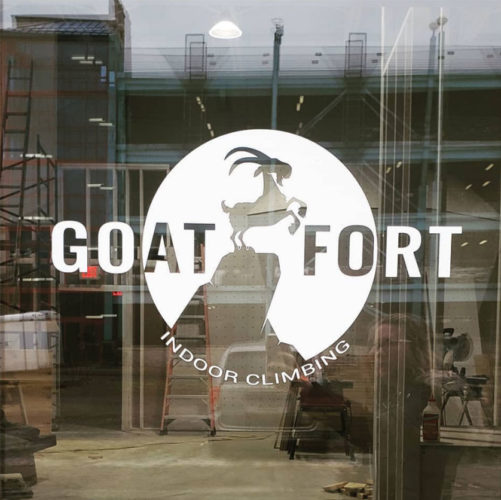
The Goat Fort Warren, Pennsylvania
Specs: New facility will feature 3,000 square feet of climbing “in a clean, open space with lots of natural light,” according to owner Dana Harrington. Harrington notes that the gym will be primarily a bouldering gym, although special classes will be offered occasionally to utilize the facility’s top-rope and lead walls. Harrington also points out that the focus of the gym will be “quality routesetting,” and the bouldering terrain will vary significantly—featuring 14-foot-tall walls and a 12-foot-tall top-out boulder. The new gym aims to be “the biggest little climbing gym on the map,” according to the gym’s Instagram bio. As a gym brand, the Goat Fort is unique. The original building was an old pole-barn on a dairy farm. However, that building collapsed under the heavy weight of snow and ice amid the harsh Pennsylvania winters. The gym was then moved to a nearby garage—where it remained for 10 years—before a decision was made to build an entirely new gym. Harrington notes that the new facility sits along the Allegheny River in downtown Warren. The new building is shared with two local outfitters (Allegheny Outfitters and Pennwild Outdoors) and a restaurant/brewery (Bent Run Brewing).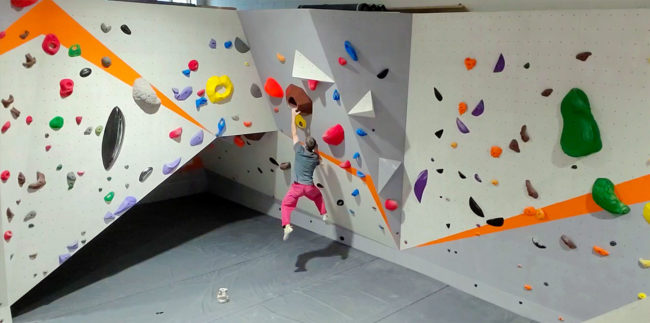
The New Climbing Hold Shapes of Summer: CHNR August Wrap
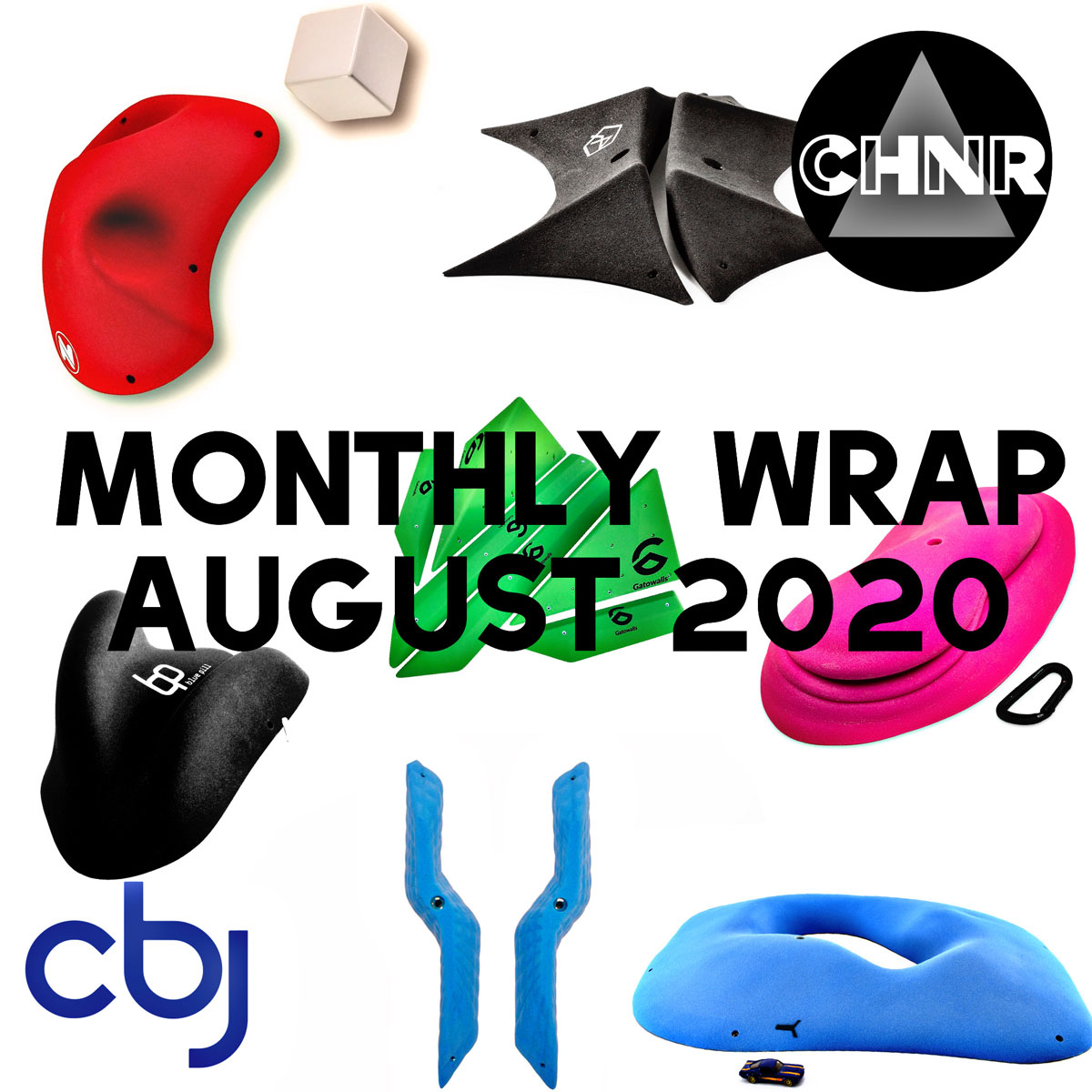 Welcome to August Monthly Wrap in cooperation with Climbing Hold News Reviews where we will bring you the latest in climbing holds, macros and volumes. Odd enough, even though we aren’t quite to Halloween, a Bat hold theme emerged this month! We hope you love this as much as we do!
Welcome to August Monthly Wrap in cooperation with Climbing Hold News Reviews where we will bring you the latest in climbing holds, macros and volumes. Odd enough, even though we aren’t quite to Halloween, a Bat hold theme emerged this month! We hope you love this as much as we do!
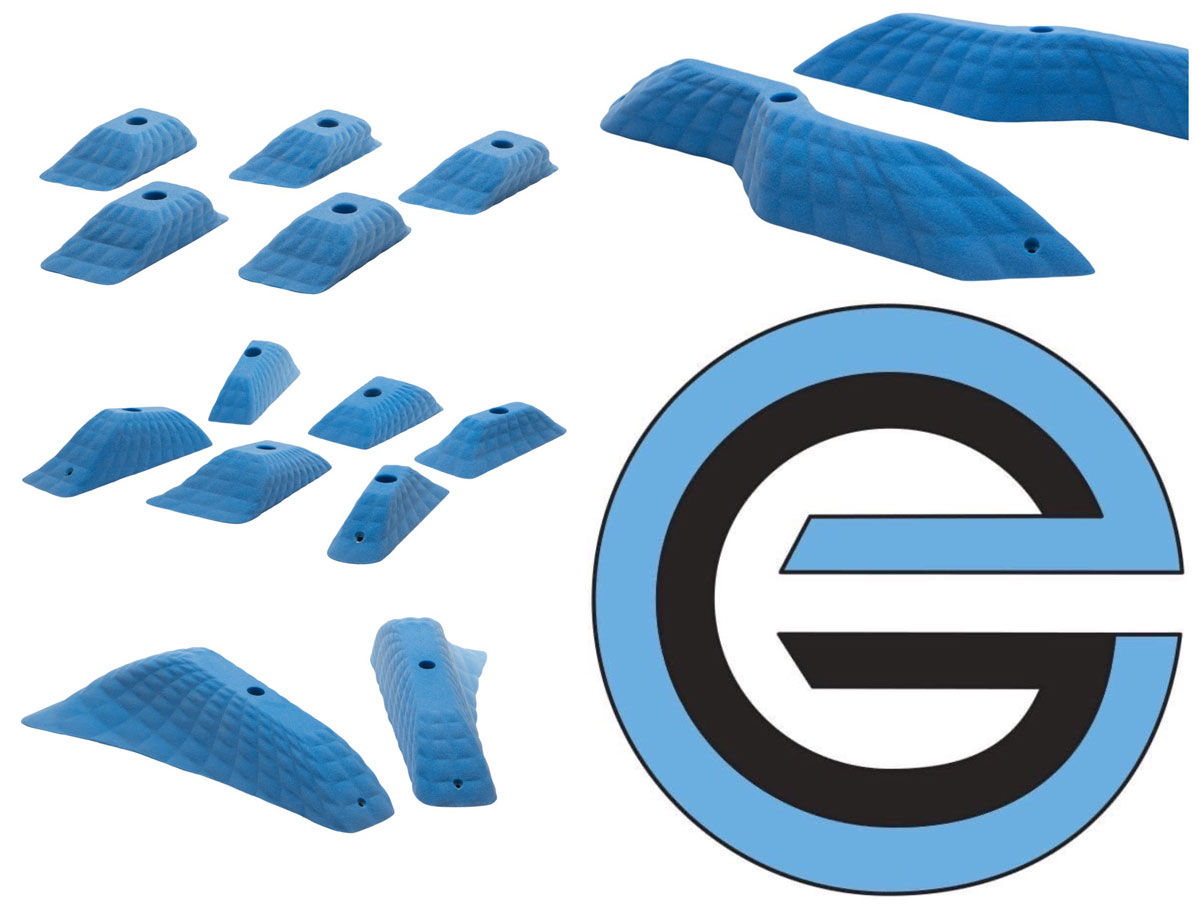
E-GRIPS
E-Grips has released several new 3D rendered shapes this month which were shaped in collaboration with Render Climbing. The first set of the 3D rendered shapes is the Mosaics which feature symmetrical textures, precise angles, and the ability to exactly scale to any size. The texture also “forces climbers to make small haptic adjustments after grabbing the holds.” They will be starting this series with the Mosaic Mini Jugs, Mini Pinches, The Bolts and the Mirror Pinches. They are also releasing the Sand Dollar Slopers and Sand Dollar Dome, which also feature a unique texture, and the Bat Wing Edges and Ledges. e-grips.com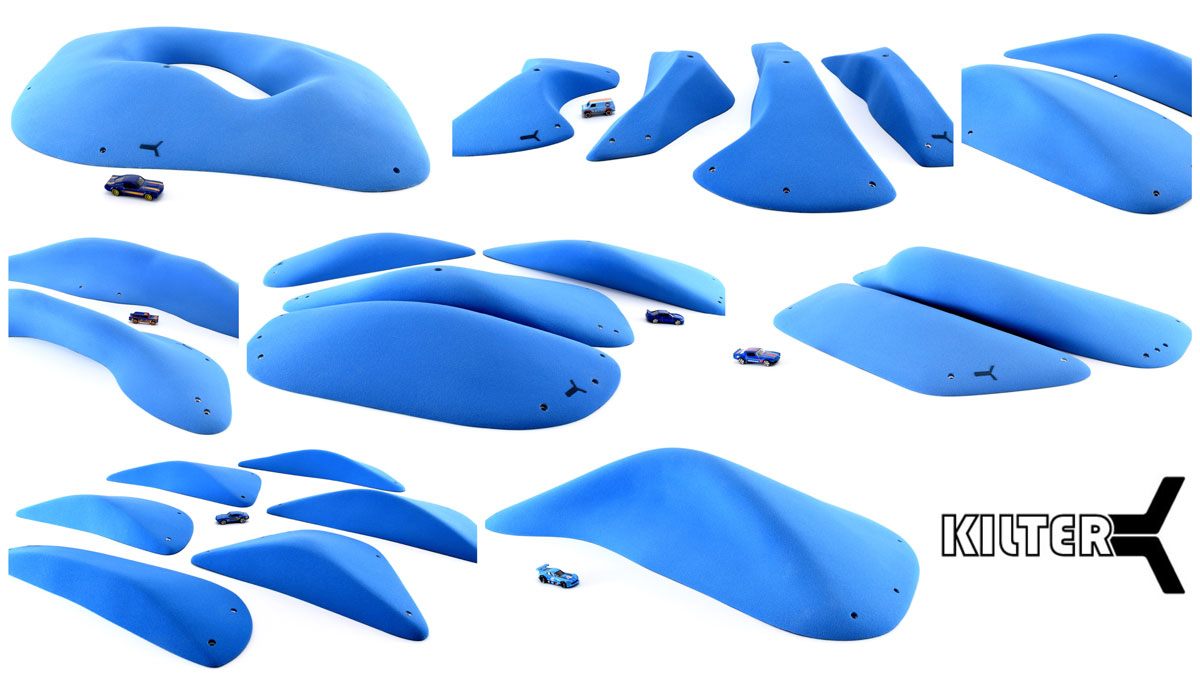
KILTER
Kilter has released all kinds of new grips for the month of August. They released over 55 new fiberglass shapes from Walltopia including expansions to previous series such as Winter, Noah and Flö. A new series, Wingate Sandstone, has emerged and features pinches and ledges with crisp yet rounded edges and gently sloping sweeping curves. In addition, they also released many new polyurethane holds from Aragon and Composite-X such as new Granite Kaiju, Granite Complex, Brushed Sandstone Ribs and Fins, Sandstone Mixed Edges, Noah Fins, Jimmy’s Southern Sandstone Kaiju Slots, and Winter XL 90 degree, 60 degree, and 30 degree stacks which are customizable holds able to be blocked by each other and other Complex series holds at each specified angle. Check out the link below under the New Holds section to see the full details. settercloset.com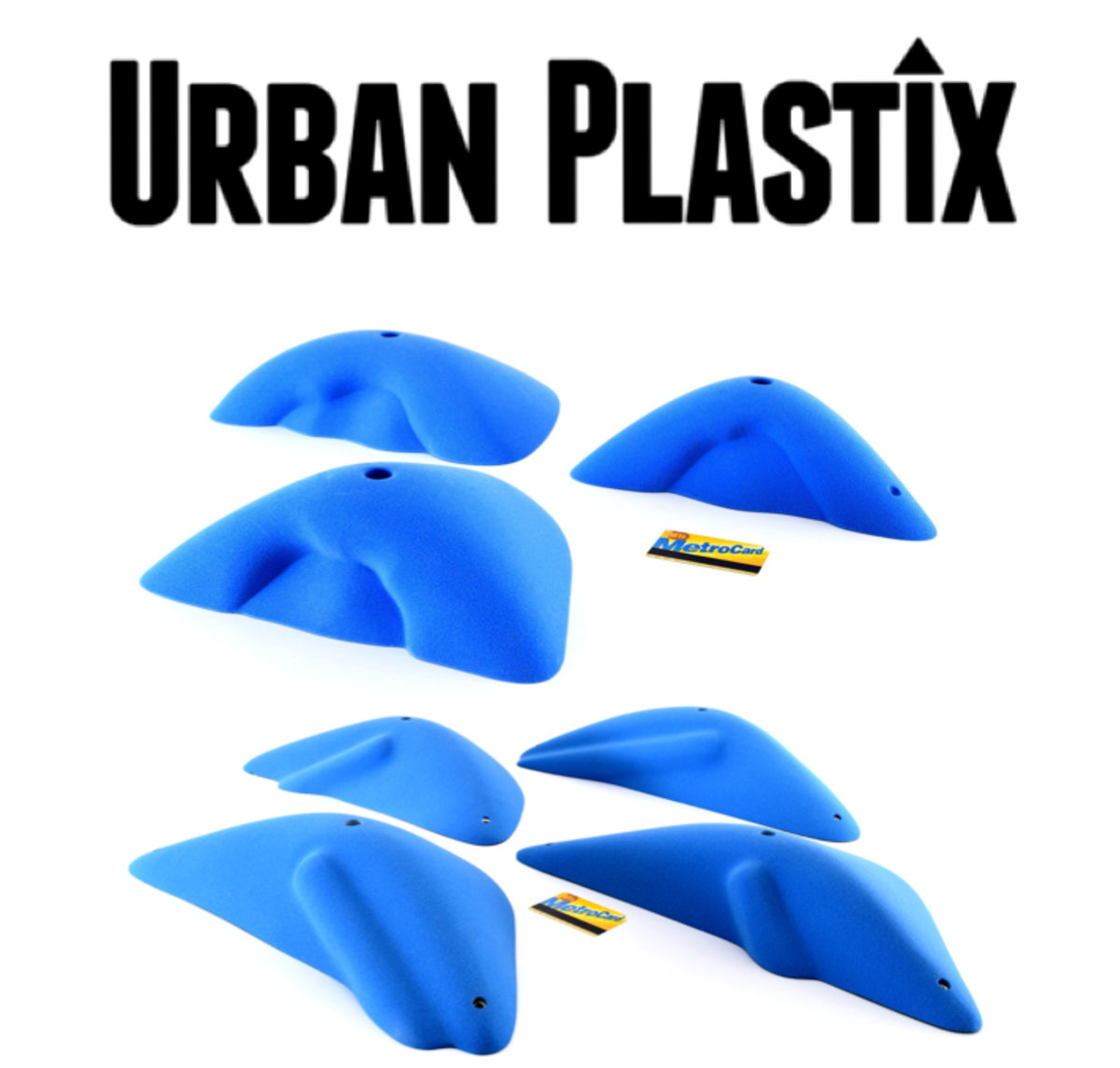
URBAN PLASTIX
Urban Plastix is new to the fiberglass game but also released some new shapes with the new XL Speed Bumps. July saw the release of a new PU line called the Strato series and in August the line was expanded with the new XL Strato Sloper Ledges. Check out our July Monthly Wrap if you missed it. urbanplastix.com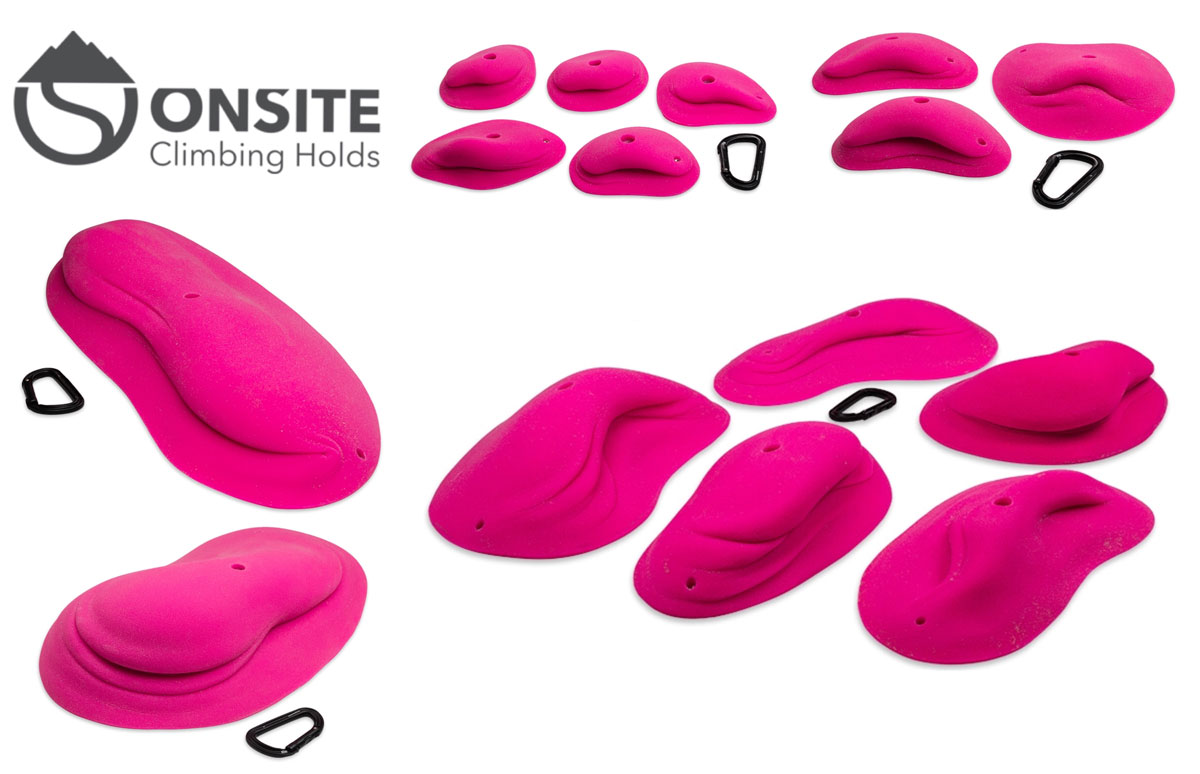
ONSITE CLIMBING
OnSite is undergoing a relaunch and has released their first line, the Epidermals, which are poured by Proxy / Vertical Solutions. This line is a series of crimps that look like rolled up skin or fatty tissue which is exactly from where they derive their name. There are currently holds available ranging in size from medium to two jumbo features with more planned on the way soon by mysterious shaper/climber Heel Hook Harry out of Wooden Mountain Bouldering Gym in Loveland, CO. onsiteclimb.com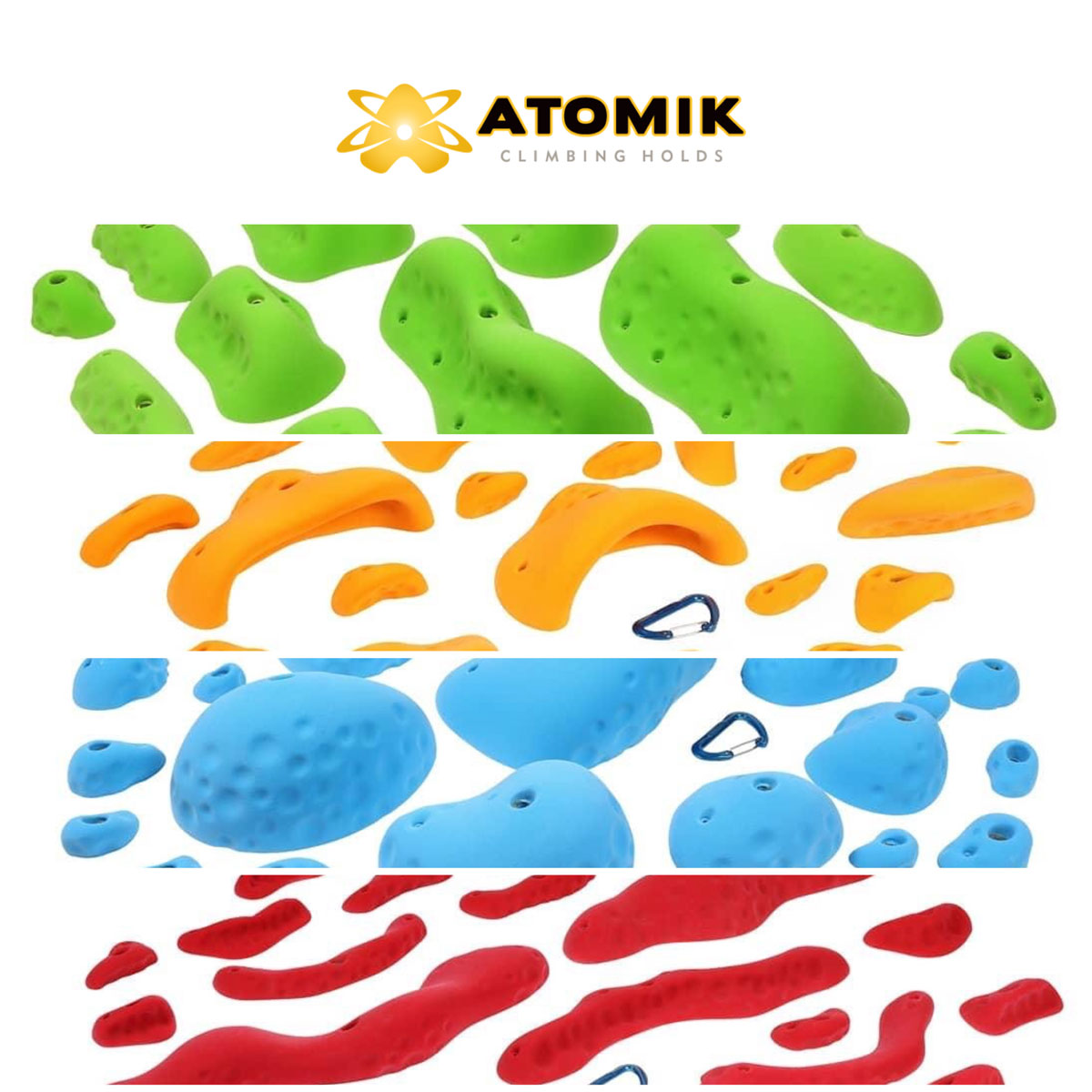
ATOMIK
Atomik has officially released about half of their newly reshaped Golfus series with more expansions are planned for the future. A recent post on their social media shows the variety of hold types this series possesses including Pinches, Jugs, Slopers and Rails all possessing the characteristic dimpled texture of the original Golfus series. The rest of the Golfus line is due to release soon. atomikclimbingholds.com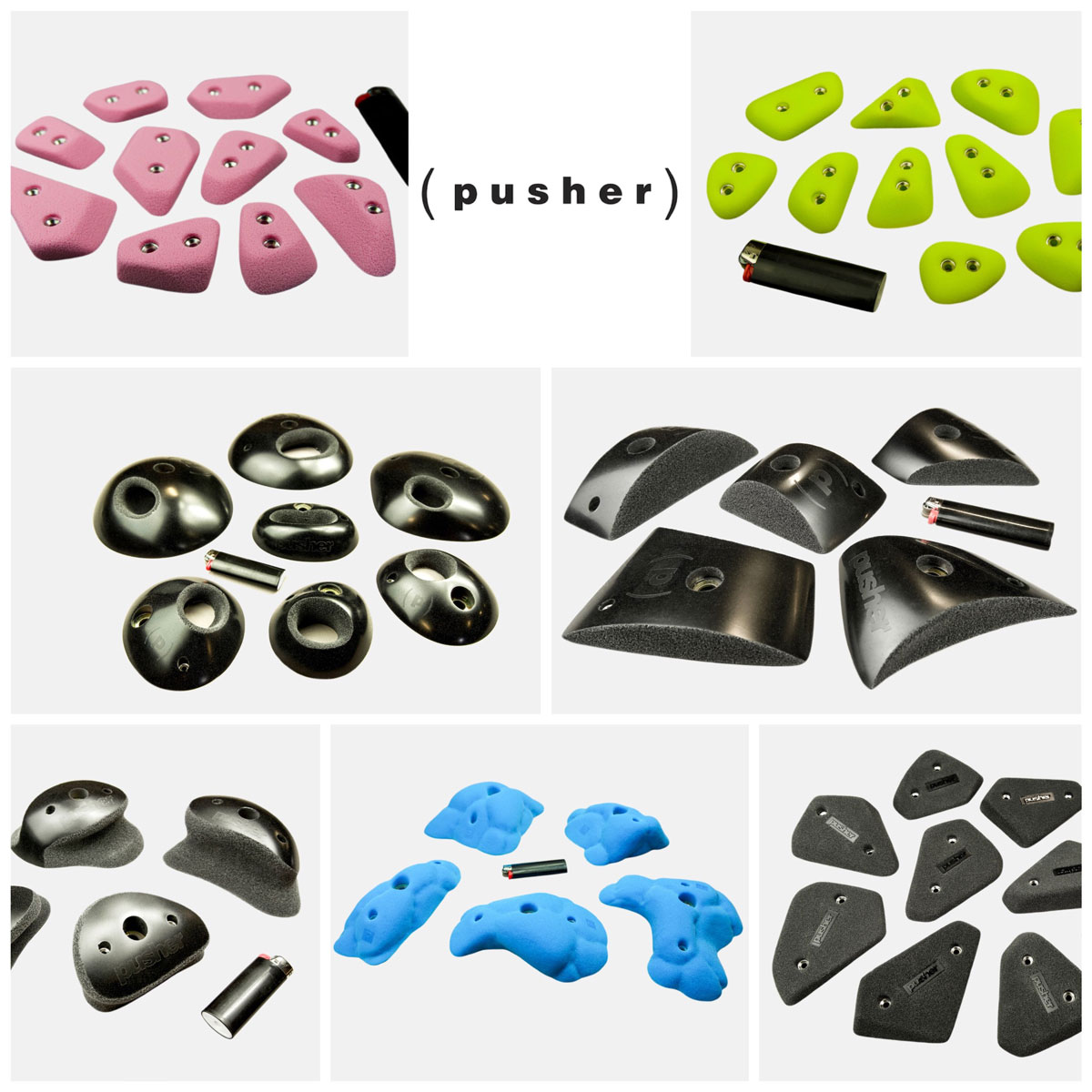
PUSHER
Pusher is back with new releases featuring redesigned dual texture original shapes from climbing legend Boone Speed. In addition, Pusher has also released new home wall sets shaped by Jared Roth including a mini Font set (in blue) and angled hand (black) and foot jibs (lime green and light pink) which are now being poured in house. pusher.world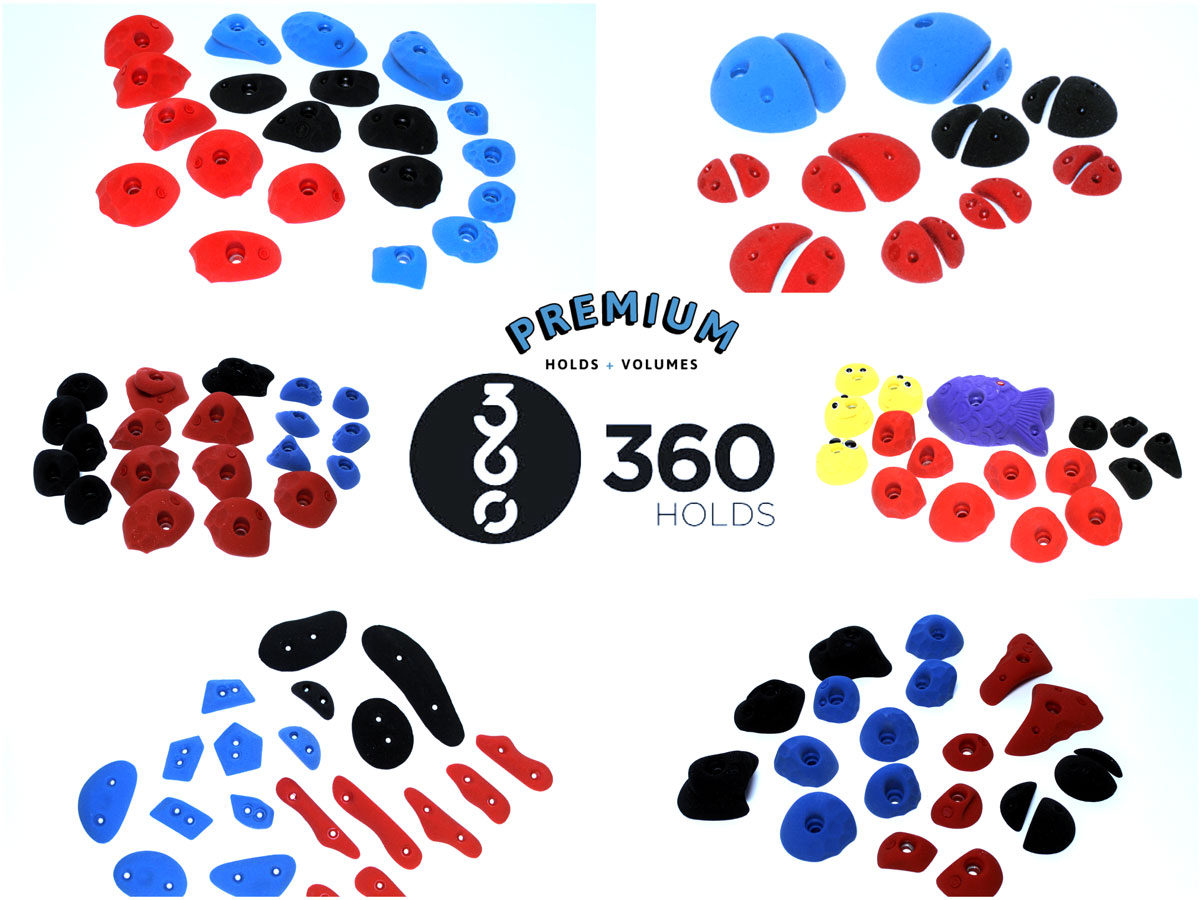
360 HOLDS
360 Holds is expanding from their commercial roots and releasing new Home Climbing Wall Kits. There are a total of six sets including holds for kids, beginner, intermediate, advanced as well as a micro kit and home wall start up set. These holds are available exclusively through Premium Holds based out of Dallas, TX. 360holds.com premiumholds.com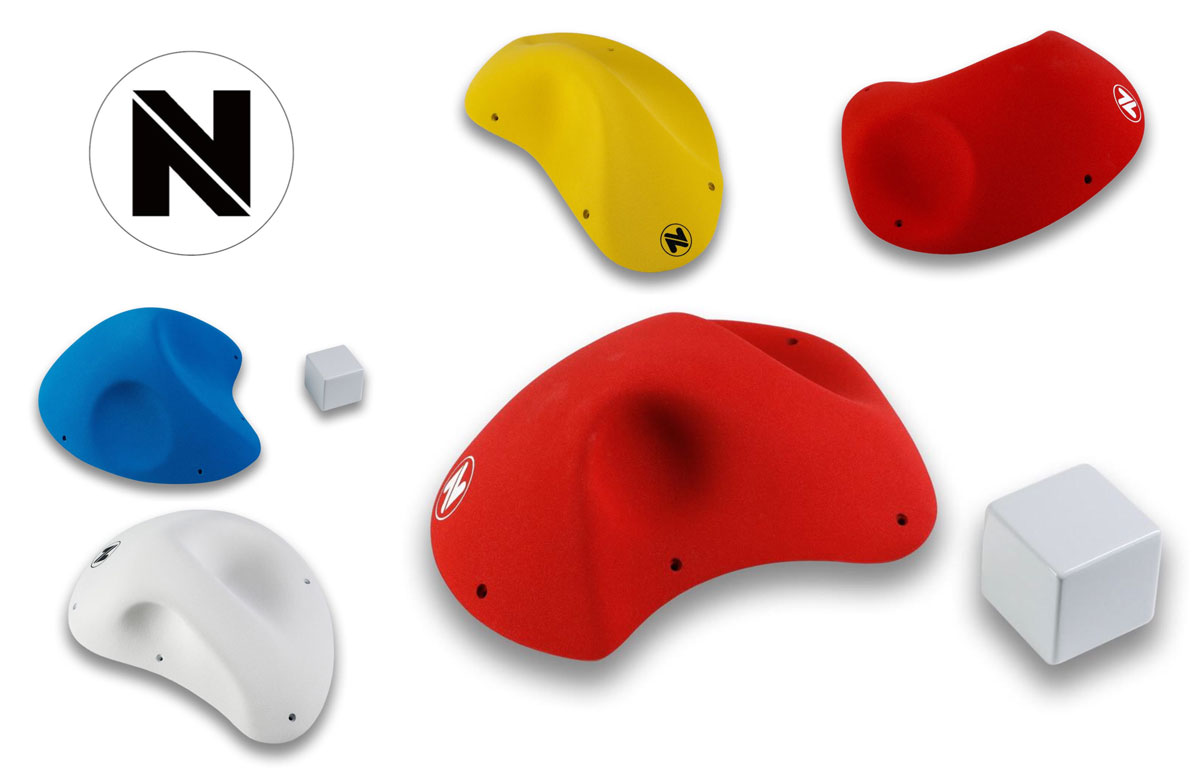
NEO HOLDS
Neo Holds is a South Korean based company which is releasing their second generation macros designed in collaboration with 360 Holds. There will be a total of twelve variably sized scoop macros with six in the Genesis series and six in the Absolute series. These macros do not have a flange and feature reinforced washers standard with 360 Holds. They will be available in the standard ten 360 Holds colors, available in Europe through the Holds Gallery and Butora in Asia. They are not yet distributed in the United States though that will likely change in the near future. neo-holds.eu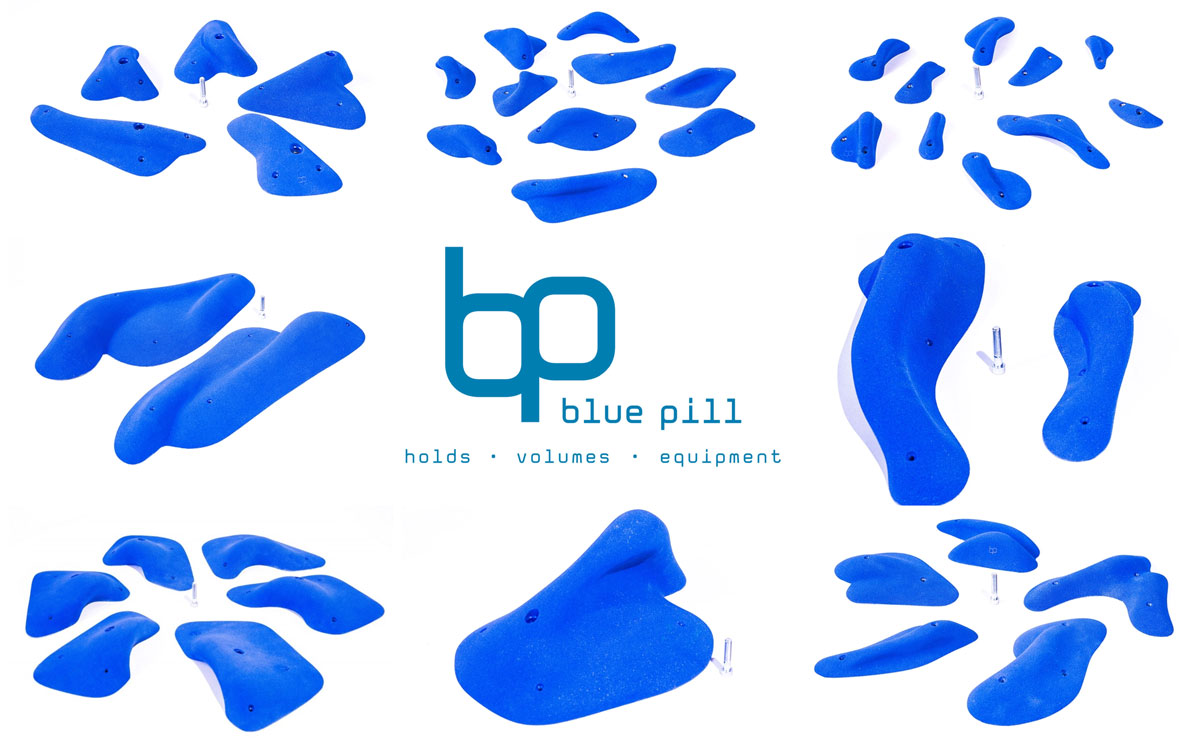
BLUEPILL
Bluepill has released the Originals which are a series of bulbous crimpy and sloping lips in both fiberglass and polyurethane (shown in blue). Bluepill macros and volumes are distributed exclusively by Blocz Distribution in the United States while Bluepill holds are poured and released exclusively by Proxy (Vertical Solutions) in the United States. bluepill-climbing.com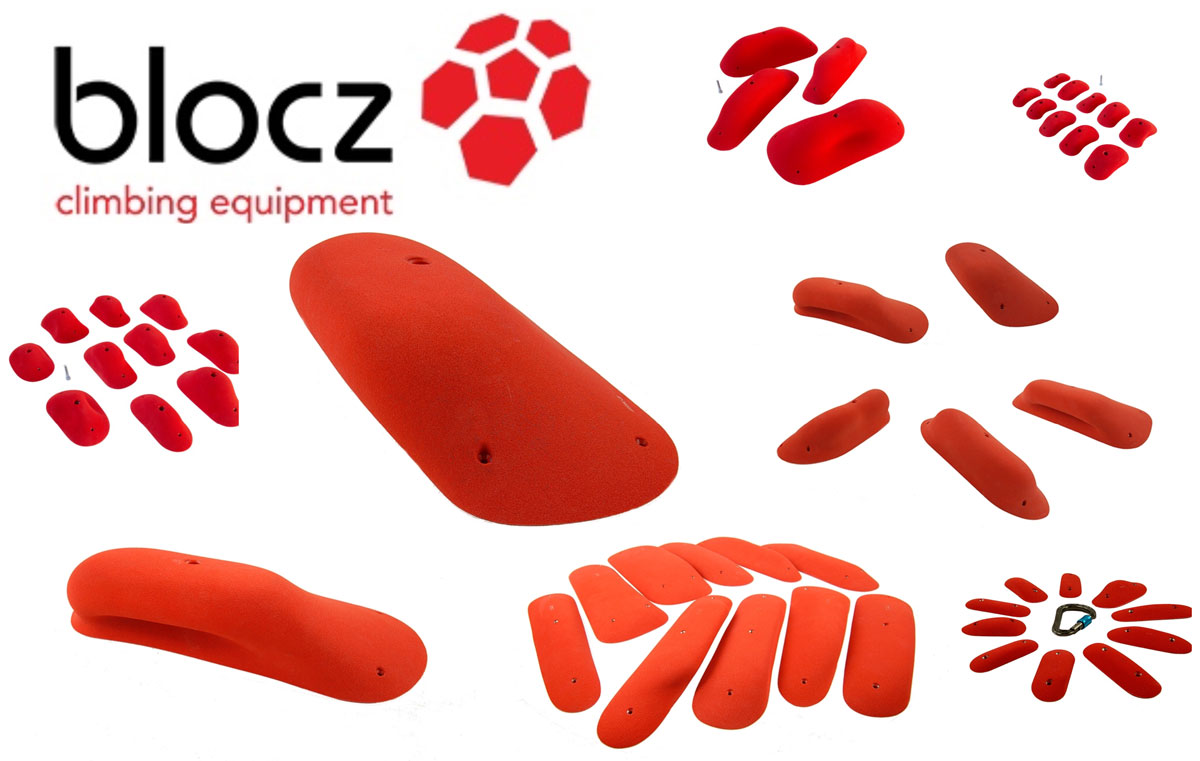
BLOCZ
Blocz is releasing a series of bread-inspired names with a mixture of screw-on and bolt-on polyurethane edges, jugs and pinches. There are a variety of holds ranging from small to 2XL sizes which expand their existing lines of edges, jugs and slopers. blocz.com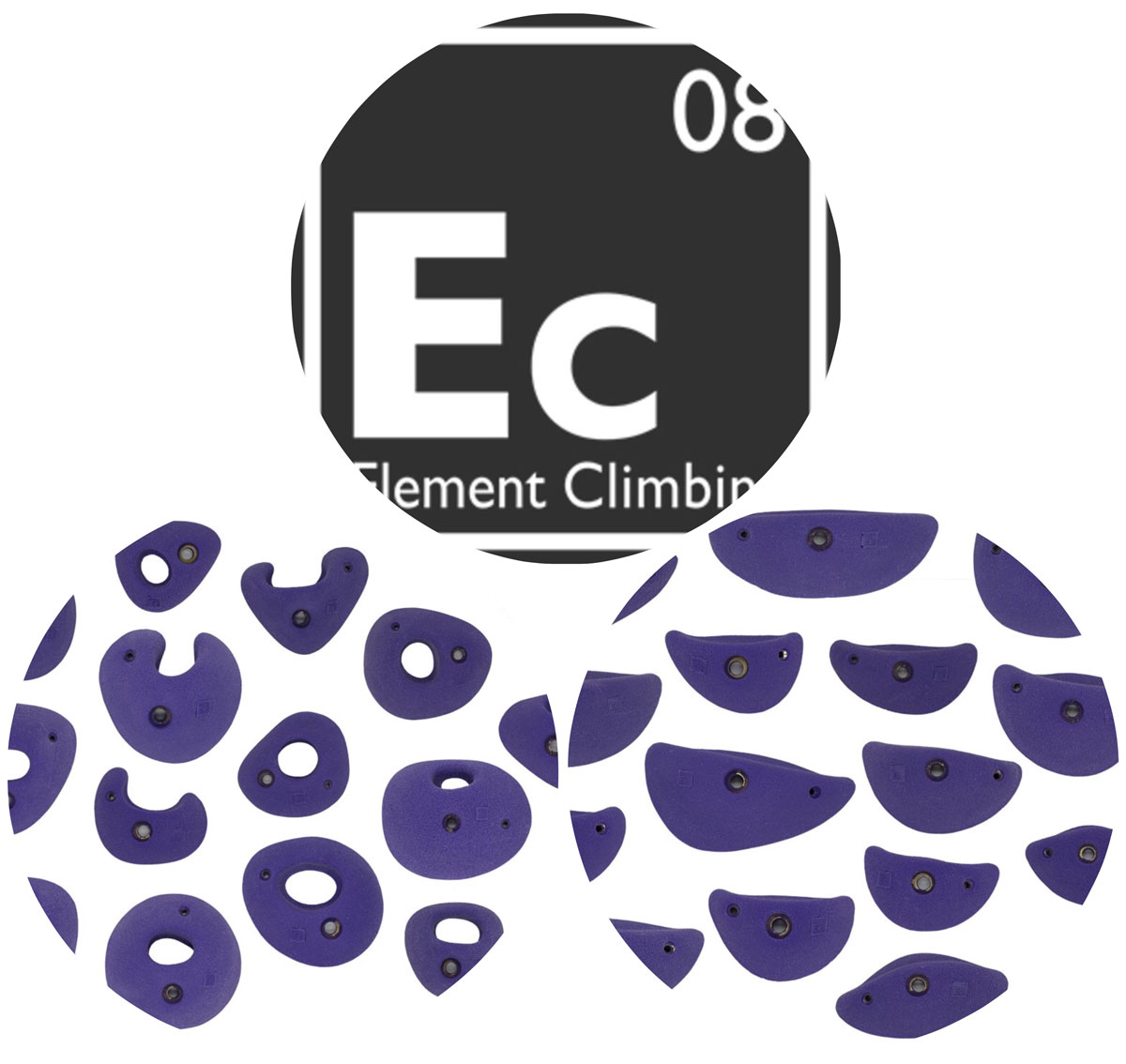
ELEMENT
Element has been quiet for a while, but new releases are on the horizon including these two new sets shaped by master shaper Louie Anderson – the Confluence Pockets and Crimps. These are an expansion to the existing Confluence series featuring smooth stalactites, pinches, jugs, edges and jibs. The new two new pocket sets and four new crimp sets are available individually or together as a super set. elementclimbing.com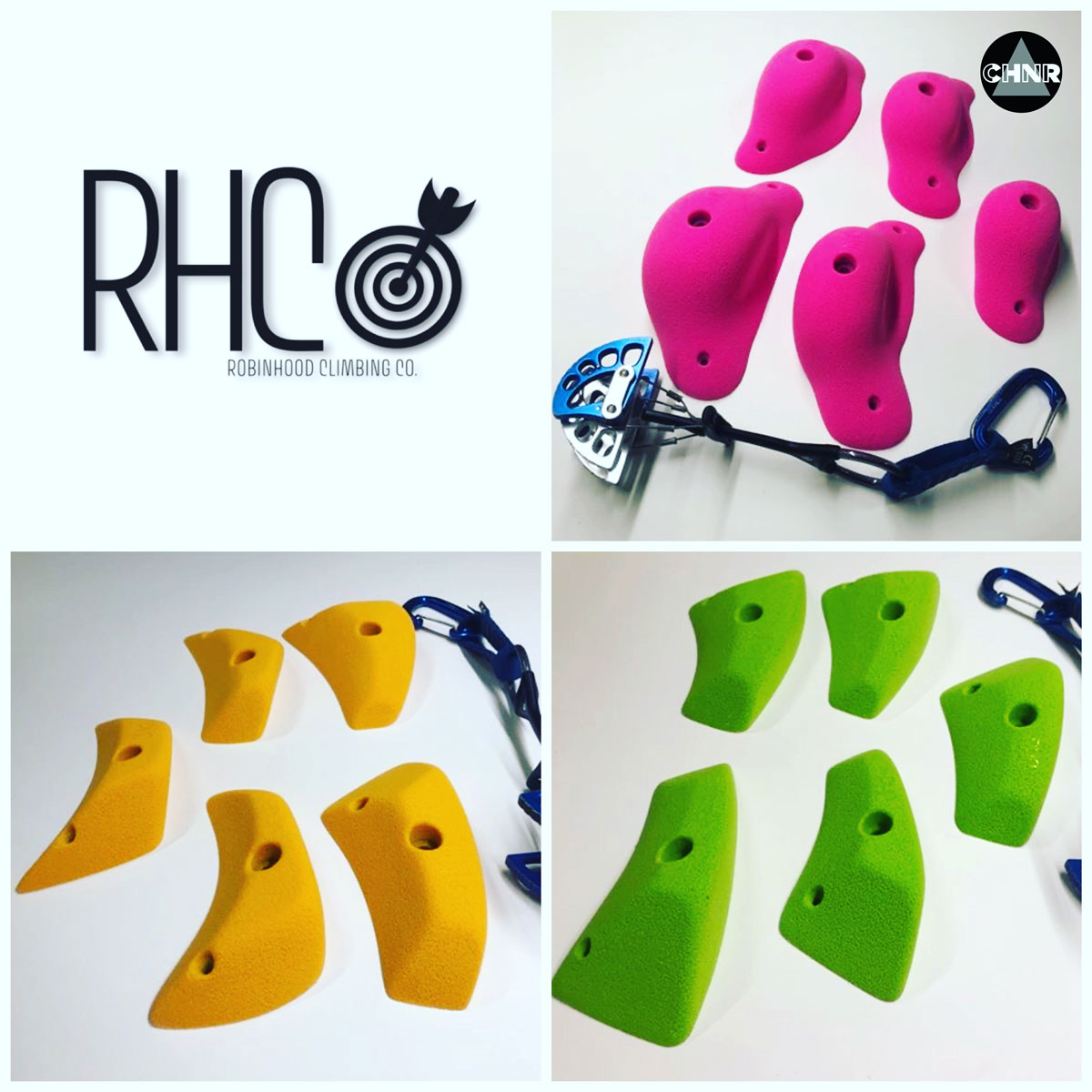
ROBINHOOD
Robinhood has released three new sets which is giving us a preview of things to come. Introducing the Medium Foundation Flat Edges (in green) and Incuts (in yellow) as well as the Medium Slug Pinches (in pink) all shaped by Andy Nelson of Method Grips. robinhoodclimbing.com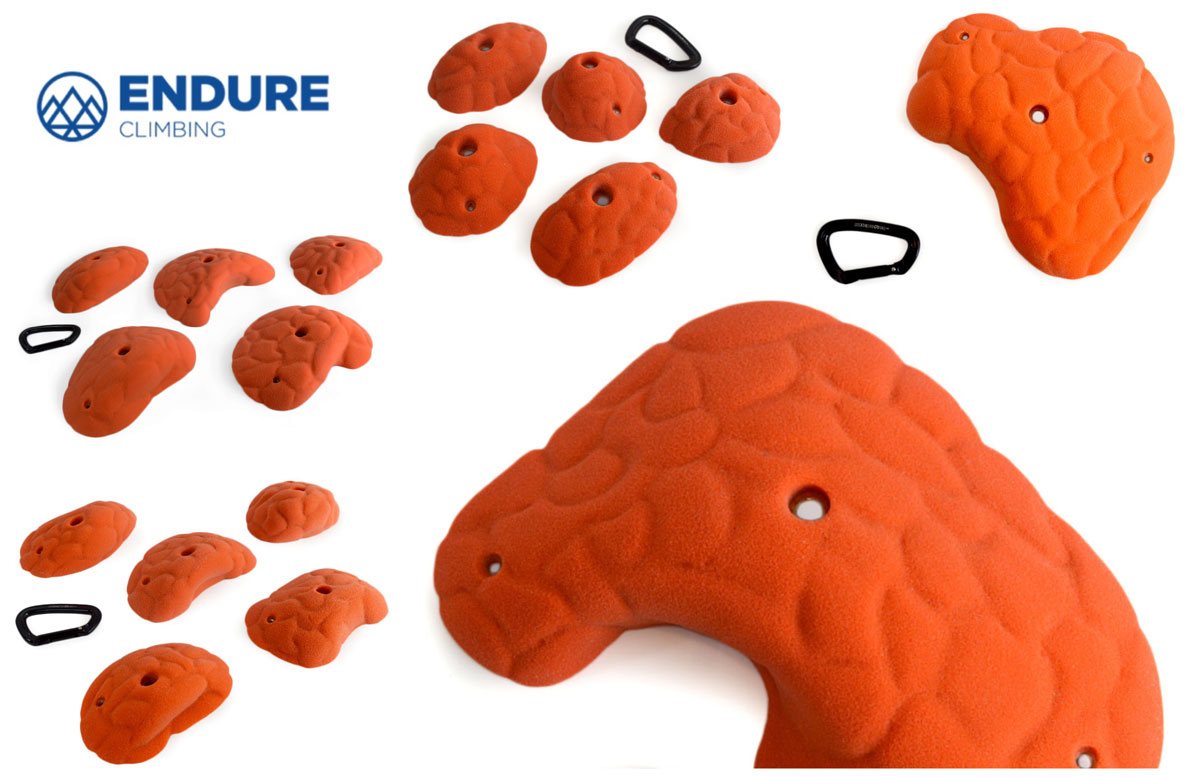
ENDURE
Endure is a small batch holds company based out of Richmond, VA. Recently they have released the Furrows which were carved by experienced shaper Kegan Minock. These holds are a series of Font-shaped holds ranging in size from small to 2XL currently with several larger features planned, together the most complete series Endure has released to date. They have also released a newly redesigned set of Teacups which are smooth positive jugs in different incremental sizes. climbendure.com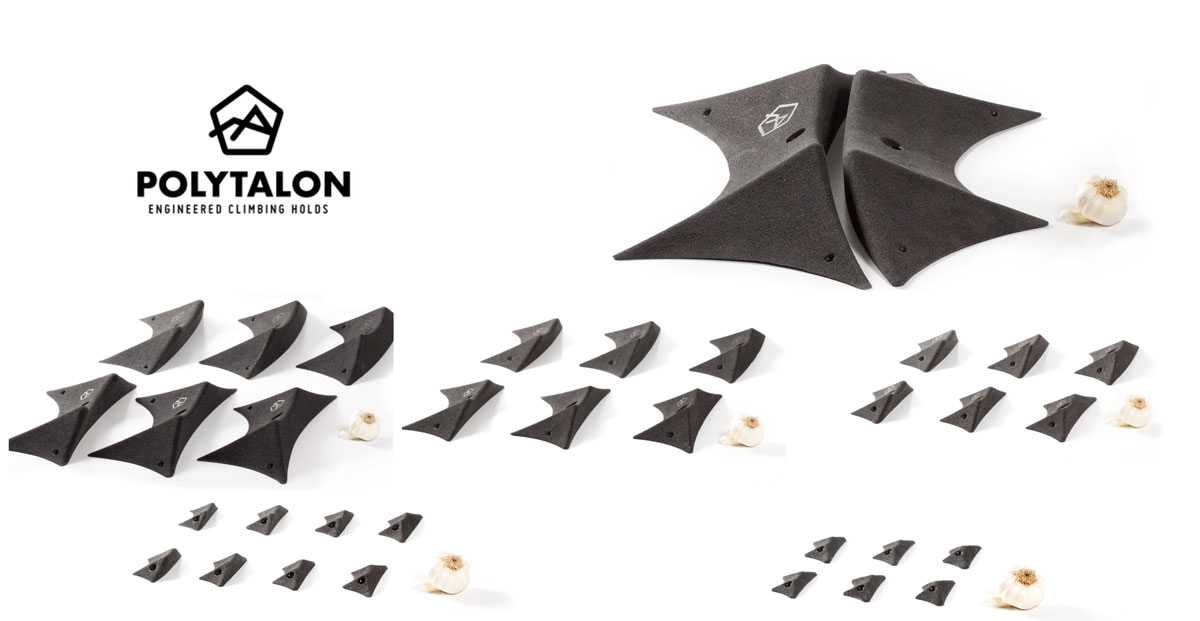
POLYTALON
Polytalon is a German-based brand which features highly engineered production processes. Their latest series The Bats were 3D modeled and produced with conventional yet upgraded eco-friendly manufacturing. The Bats are a series of variable size and angled edges designed to be used together as blockers which will be available in both full texture and dual texture. The series ranges from XS to 2XL in size and are currently available in eight colors – but why would you want the Bats in any other color besides black? polytalon.com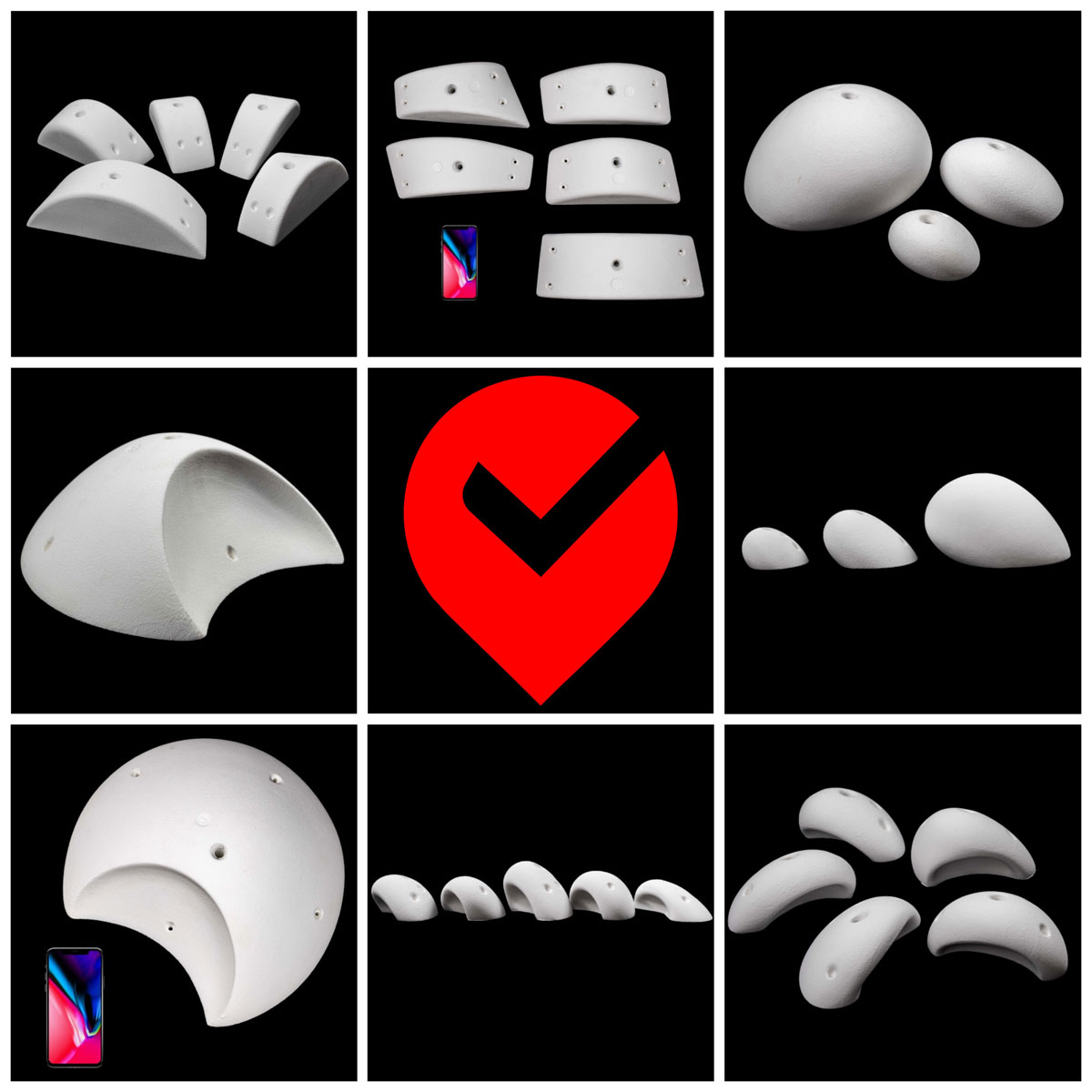
SATELLITE
Satellite is a hold company from Japan that has recently released tons of new grips from XS to multiple XL shapes. They have recently added on the Decamaboco pinches, Super Round Jugs, Ball Ball slopers and the scooping dish Apollo 2XL holds #4 and #5. We also spotted the Shinka 2XS sharp and mild crimps on their website. Satellite Climbing is exclusively distributed by Solostile Climbing Lab in the United States. satelliteclimbing.com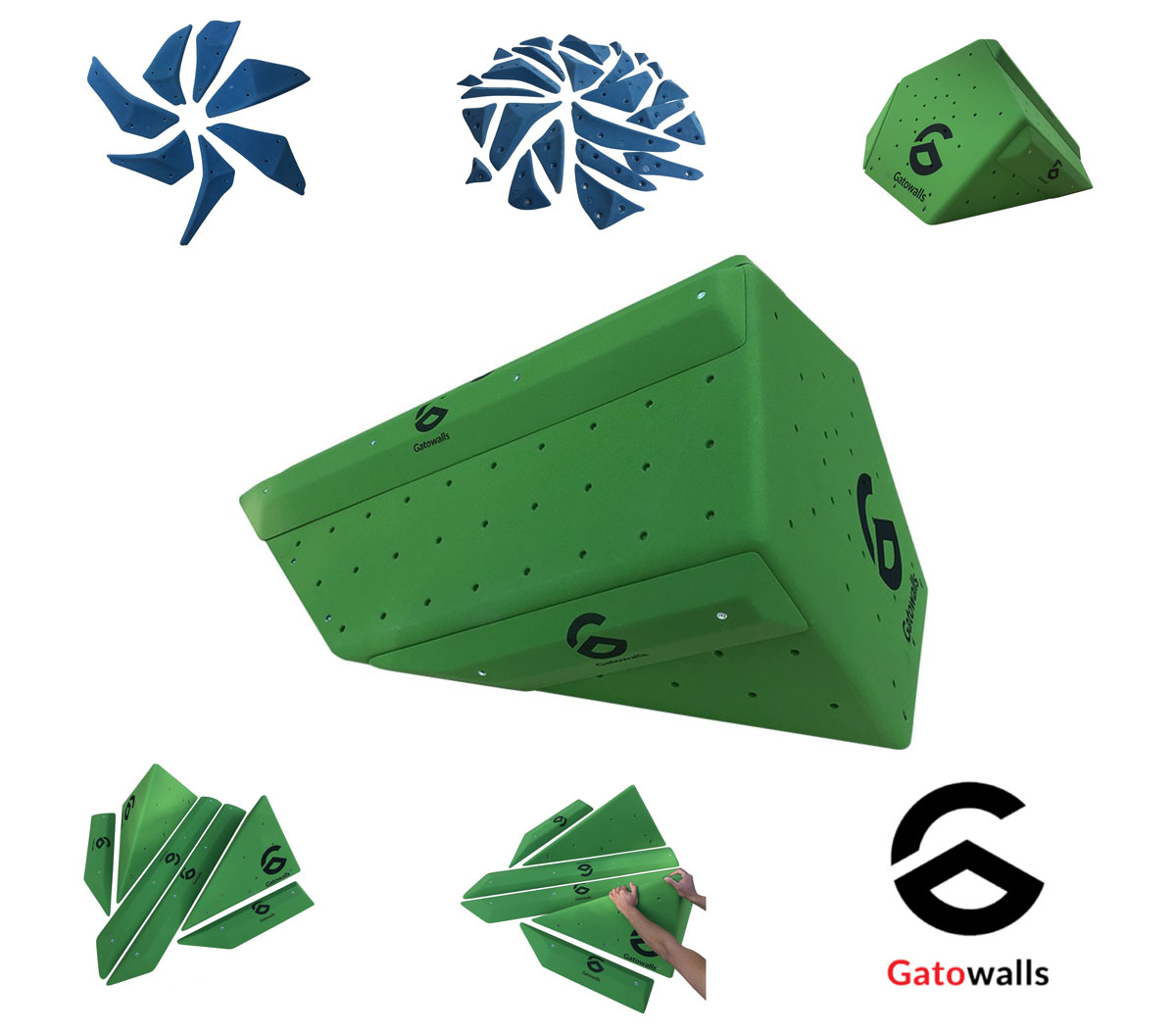
GATOWALLS
Gatowalls is a newer producer of climbing holds, macros, volumes, training equipment and climbing walls out of Poland. This month they continued growing their line with the new Pentagon shaped volume (shown in green) as well as additions of the Titanic I and II as well as the Pyramith I, II and III volumes. These are symmetrical left and right sided volume add-ons which are specifically designed to fit on the Pentagon volume. They have also released a new line of holds with the Wings I and II (in blue) which are comp style edges shaped by Michau Jedrzejewski. gatowalls.com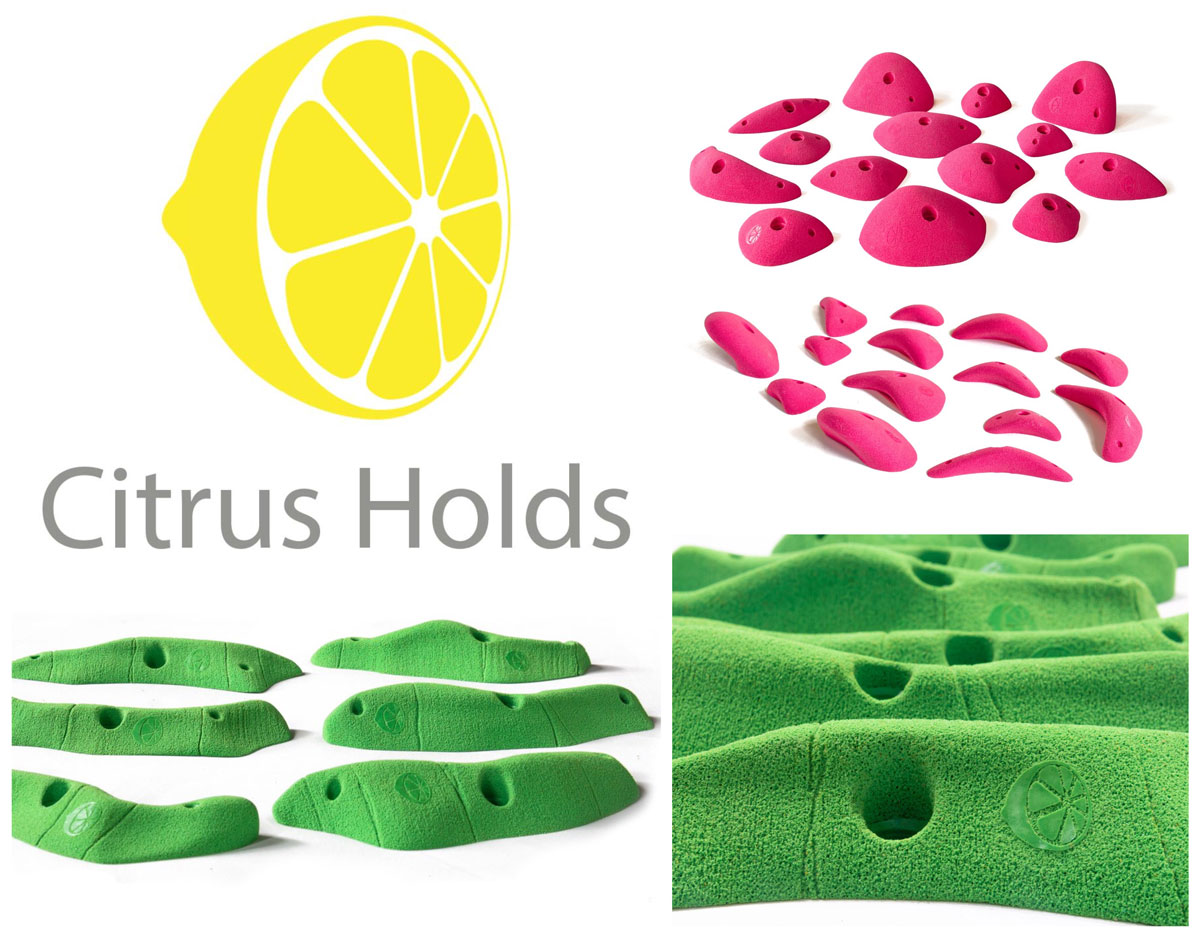
CITRUS HOLDS
Citrus Holds based out of Canada is a brand that we haven’t seen much of in the US yet, but their available hold lines are growing quickly. They have recently released the Basic Jugs (shown in pink) which is a series of fourteen variably positive holds designed specifically for easy walls / climbs. The Sandstone Fossils (in green) are also new and are six rail and pinch shaped holds which are wide enough for both hands. citrusholds.com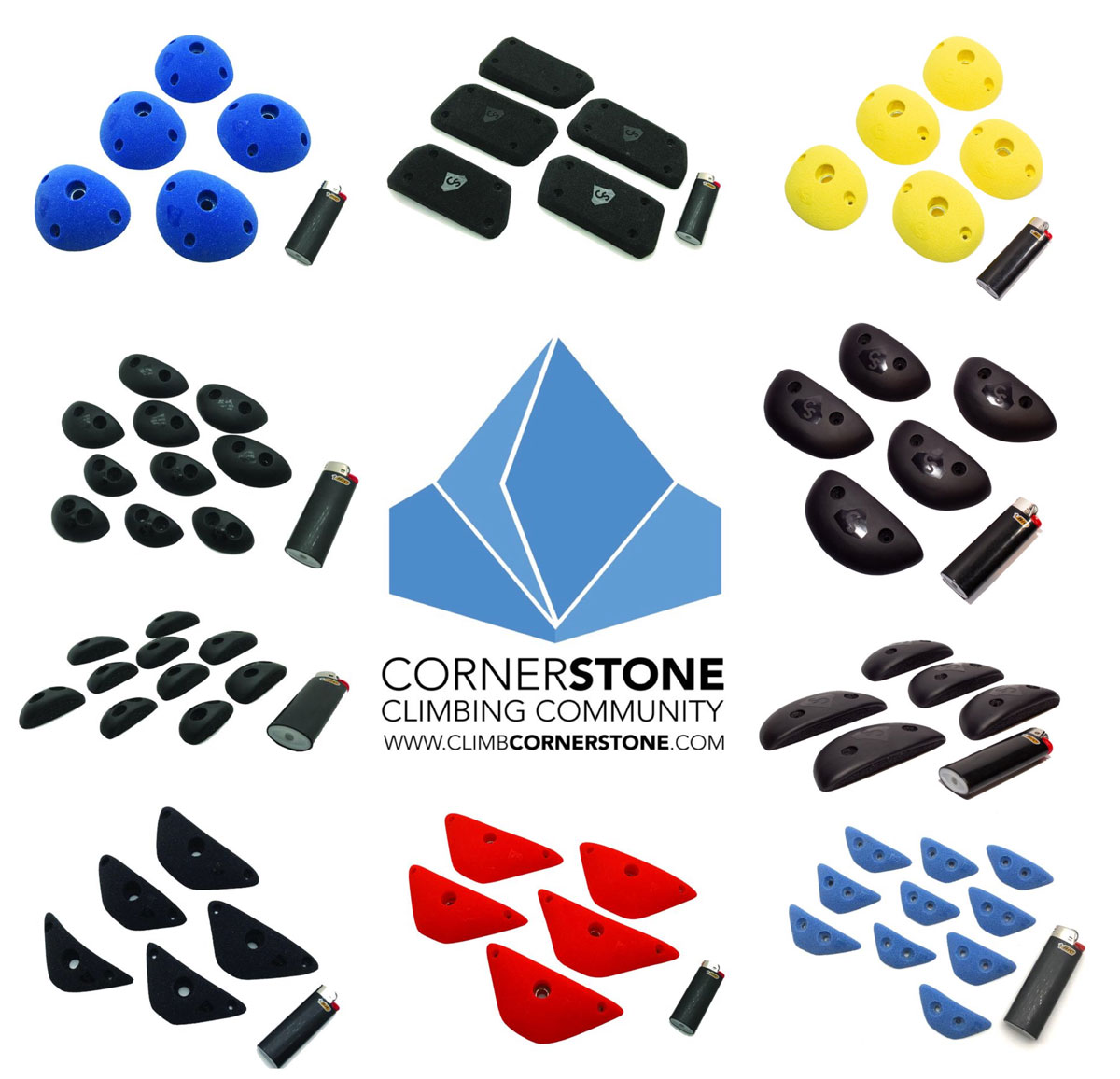
CORNERSTONE CLIMBING
Cornerstone Climbing is a brand-new hold company emerging from Canada. They have been quietly building new lines of holds, starting with a focus on smaller shapes. Shaper Kiefer Burrows has released several new series including the cobble-crimp Originems (shown in yellow), Patchwork, Vanisher edges (red and black), Blind Eye slopers (blue) and the dual texture edge Havoks (also black). Their website has just launched. climbcornerstone.myshopify.comHWOW 21 – A New England Carpenter’s Masterpiece
This week’s HWOW takes home-gyms to a new dimension. The Hell Cave, a Moonboard, and a sweet bluetooth system make Jed P’s home gym in Madbury, NH, the ultimate training dojo. Check out past HWOW here.
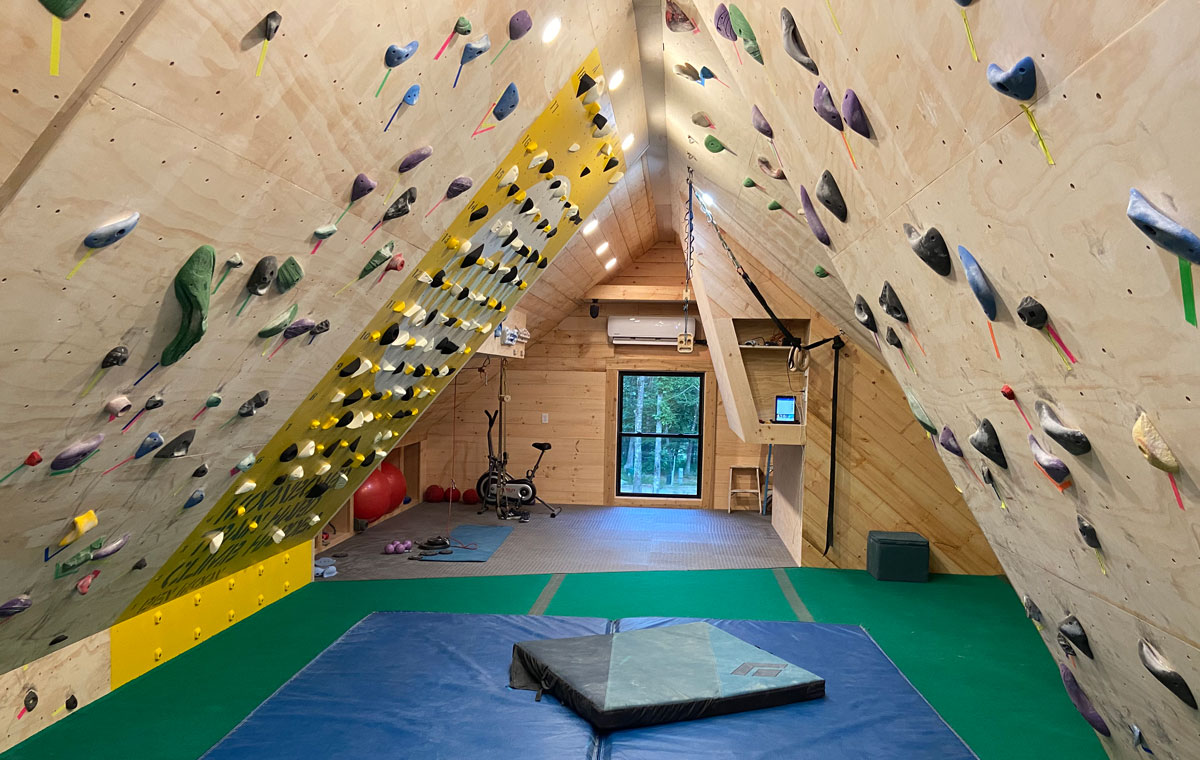
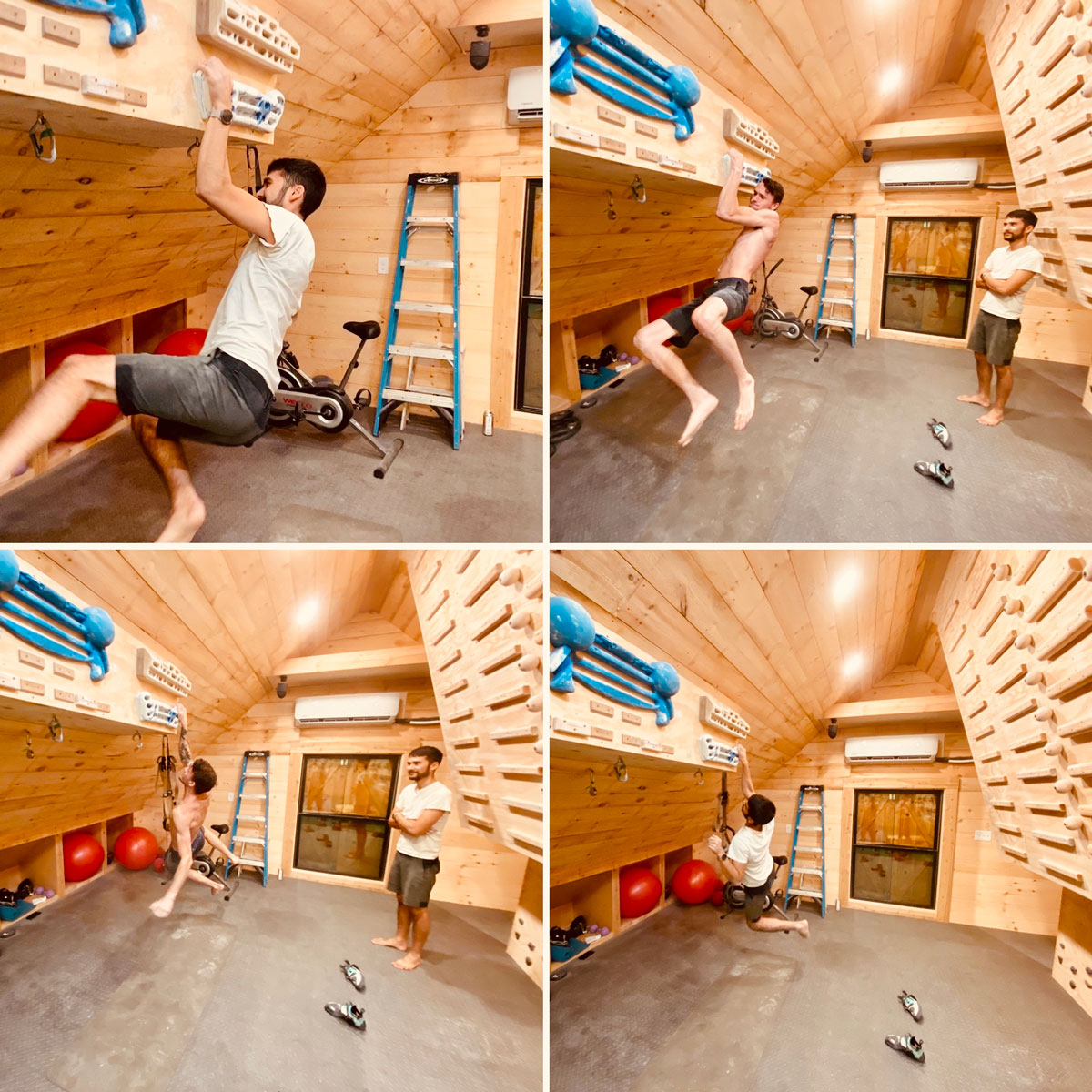
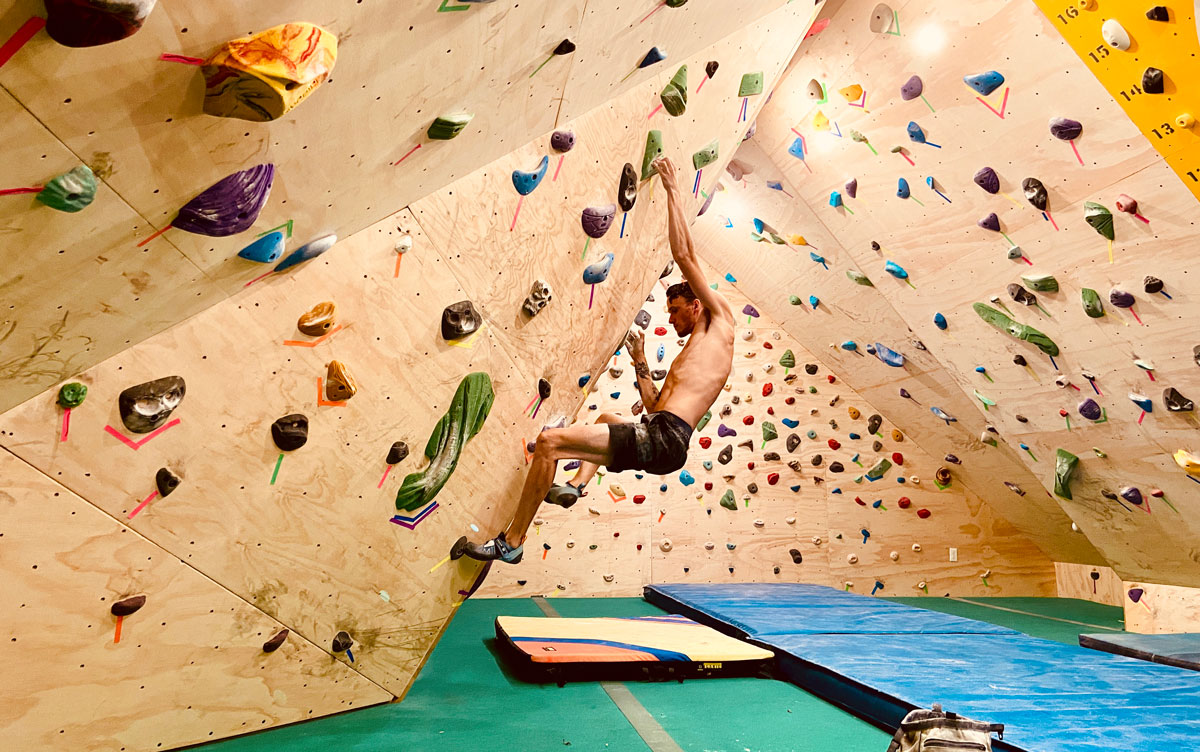
Want us to consider your woodie for a future Homewall of the Week? Submit your homewall here to be considered. If yours is chosen you’ll win a prize like this (prizes vary each week):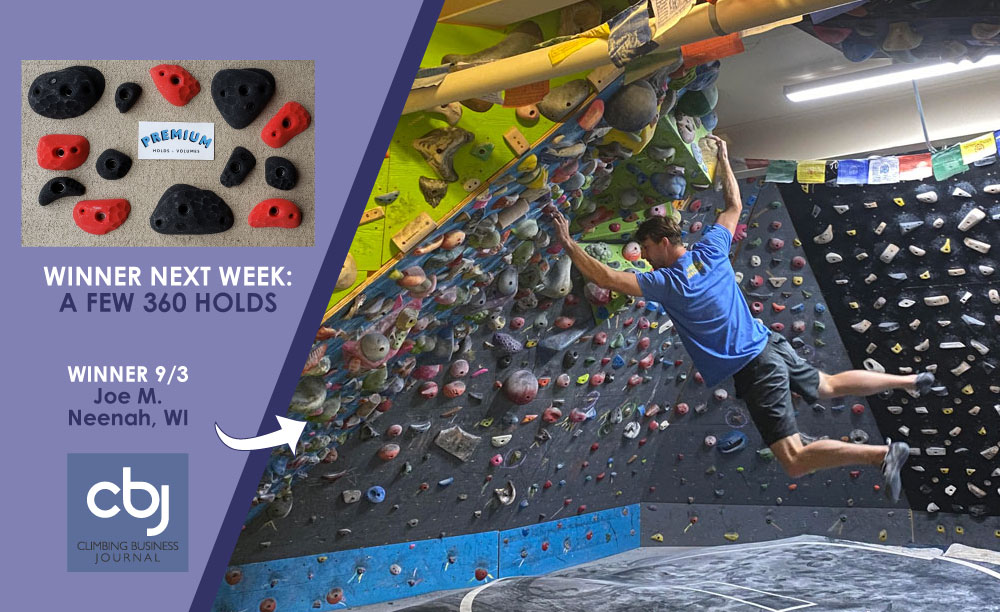

When did you build your wall? Was it a COVID baby?
This spring, but we were planning it since 2018. I started thinking of this build back in 2016 when my wife and I started building our house. I knew there would be usable space above my wood shop and remember standing up on a frozen deck in a snowstorm figuring heights and widths of the attic so I could build the cave.How long did it take you to build and what did that time look like?
3 months. Workdays really varied with what we were doing. Some days we would be framing and others we’d run duct work and set up the mini split and air filtration. I was working on the project in between work, some evenings, and every weekend. On the weekends I would work 10/12-hour days to get it done. I definitely burnt the candle at both ends and my wife was there helping and supporting me with every aspect of the build. If I was working on the cave it was nonstop. Towards the end of the process, I realized between my job and the build I had worked over 90 days straight and a lot of them over 8 hours a day. I’ve been a finish carpenter for over 20 years with lots of experience in other trades. This build was a point of pride for me: I’m a climber and a wood worker and I wanted the Hell Cave to show that!!!Who helped you with the build?
It was mostly me and my wife building but friends in our COVID bubble did come and help when tasks were just too big. My friends Todd and Chris were hands on! Todd saved me by helping with the insulation and hauling heavy items up the ladder. Chris came and did 90% of the electrical. If it weren’t for these two, I’d still be building the Cave. One of the best parts about the cave is how the community came together and donated to buy holds and training equipment!!! If it wasn’t for Korey’s iPad donation to run the Moonboard, as well as music and dollars from Haji, Andersen, Little Will, and Vivian, we wouldn’t have all the different holds and campus equipment we have!!! When friends come together, great things happen!!! I can’t wait for Covid-19 to be under wraps and have an open house to show everyone what they contributed to!!!!Not including holds and padding, how much did it cost you to build? Any surprises there?
The whole build cost approximately $16000 without the holds. I started with a budget and kept it under wraps pretty much till the end. Overages included the flooring and unseen mechanical mistakes. Most of the finances went to building out the attic, HVAC, air filtration, insulation, and the plywood for the walls. Minor costs came from adding the finishing touches, electrical, and building the stairs. The HVAC, the Moonboard, and insulation were the most expensive parts. Surprisingly, framing and electrical were the least expensive major parts of the build. Being in the trades, I was pretty spot on with figuring costs. I think I was most excited about my sound system that runs off of blue tooth and only costed us $200.
What was your primary incentive for the wall? Did anything in particular inspire your wall design?
I wanted to make a space that was clean, easy to use, and Aesthetically pleasing. It really was dictated by the space we had and a goal to keep lines clean and the space simple.What was the most difficult aspect of the design and build?
The HVAC and the aretes.What would you do differently?
I’d use all Baltic Birch panels.Did you make any mistakes along the way or choose to re-do any aspects?
There were plenty of little mistakes made but nothing that needed a re-do. Most of the mistakes revolved around the mechanicals and stuff outside of wood working.
Highlights / lowlights of the process?
The most exciting part of the build was getting all the holds on the Moonboard and setting up the training equipment. Seeing it all come together into an amazing place to train was really rewarding. There were lots of little highlights that kept us going like getting the AC running and the sound system going. There were also lots of lows. the tediousness of certain jobs such as insulation and hauling almost 40 sheets of plywood up a ladder really beat us up. A few times, frustration crept in and we would butt heads and have to take mental breaks.What is your favorite aspect?
The Moonboard and comfort of the work out space. Both my wife and I have specific routes and grades we are gunning for. We feel the Moonboard is really going to up our game.How often do you use the wall? Do you think you’ll still use it as much when all of the gyms open back up?
My wife uses the space 5-6 days a week and I use it 3-4 days a week. When it is safe to go to gyms again, we will. The ‘Hell Cave’ will be an easy place to train, while the gyms will be more just about the climbing.Any words of wisdom to aspiring homewallers?
Keep your lines simple and if you have space, have a few different angles.Want us to consider your woodie for a future Homewall of the Week? Submit your homewall here to be considered. If yours is chosen you’ll win a prize like this (prizes vary each week):





